Up close with jellyfish


The many uses for tomatoes
July 2023

Electric COOPERATIVES of ALABAMA
ALABAMA LIVING is delivered to some 420,000 Alabama families and businesses, which are members of 22 not-for-profit, consumer-owned, locally directed and taxpaying electric cooperatives. Subscriptions are $12 a year for individuals not subscribing through participating Alabama electric cooperatives. Alabama Living (USPS 029-920) is published monthly by the Alabama Rural Electric Association of Cooperatives. Periodicals postage paid at Montgomery, Alabama, and at additional mailing office.
POSTMASTER send forms 3579 to:
Alabama Living, P.O. Box 244014
Montgomery, Alabama 36124-4014.
ALABAMA RURAL ELECTRIC ASSOCIATION
AREA President
Karl Rayborn
Editor
Lenore Vickrey
Managing Editor
Allison Law
Creative Director
Mark Stephenson
Art Director
Danny Weston
Advertising Director
Jacob Johnson
Graphic Designer/Production Coordinator
Brooke Echols
ADVERTISING & EDITORIAL OFFICES:
340 TechnaCenter Drive Montgomery, Alabama 36117-6031

1-800-410-2737
For advertising, email: advertising@areapower.com
For editorial inquiries, email: contact@alabamaliving.coop
NATIONAL ADVERTISING REPRESENTATIVE:
American MainStreet Publications
611 South Congress Ave., Suite 504 Austin, Texas 78704
1-800-626-1181
www.AMP.coop

www.alabamaliving.coop
USPS 029-920 • ISSN 1047-0311
9
Visit
Country cooking
16
Beach vacation
Summer time often means time at the beach, as shown by the smiles in our readers’ snapshots this month.
Roanoke’s dolls
For 35 years in the early 1900s, a Roanoke woman created thousands of what became known as the “Alabama Indestructible Doll.”

34
Tasty tomatoes
Fresh tomatoes are at their peak this month, and we’ve got recipes using this favorite food in a variety of delicious ways.
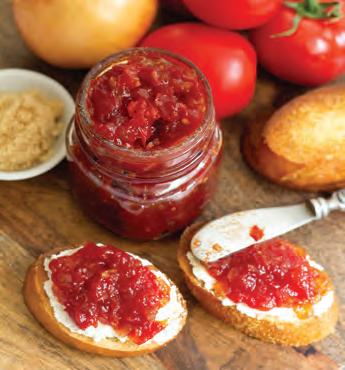
Though fascinating to look at in an aquarium, these Chrysaora quinquecirrha, or sea nettle, are the most common stinger type jellyfish on Alabama’s coast.
PHOTO:

Deepwater Horizon settlement projects surpass $1 billion
By DavidA milestone was surpassed this year when projects funded through the Deepwater Horizon oil spill settlement exceeded $1 billion, according to Alabama Department of Conservation and Natural Resources (ADCNR) Commissioner Chris Blankenship.
“The big takeaway is we have $1 billion, $29 million in projects underway in Mobile and Baldwin counties that we are managing through our Deepwater Horizon Section,” Commissioner Blankenship says. “That is 176 individual projects. That’s a lot of money and a lot of work going on. We have six people in that section, and they’re doing a very good job of managing projects that will make generational changes on the Gulf Coast.
“We never want to go through another Deepwater Horizon event, where 11 lives were lost. It was a terrible, terrible event for our coast. However, we’re trying to do good work with the money that came from that settlement.”
Replenish and protect
Among those projects are ones to replenish and protect Alabama’s living coastal and marine resources.
“That includes restoration of oysters and oyster reefs,” Blankenship says. “We’re building about $30 million in artificial reefs. We’re increasing funding for research for stranding response for marine mammals and sea turtles, conservation of bird nesting and foraging habitat as well as construction of a wildlife rehabilitation center and sea turtle triage facility in Orange Beach.”
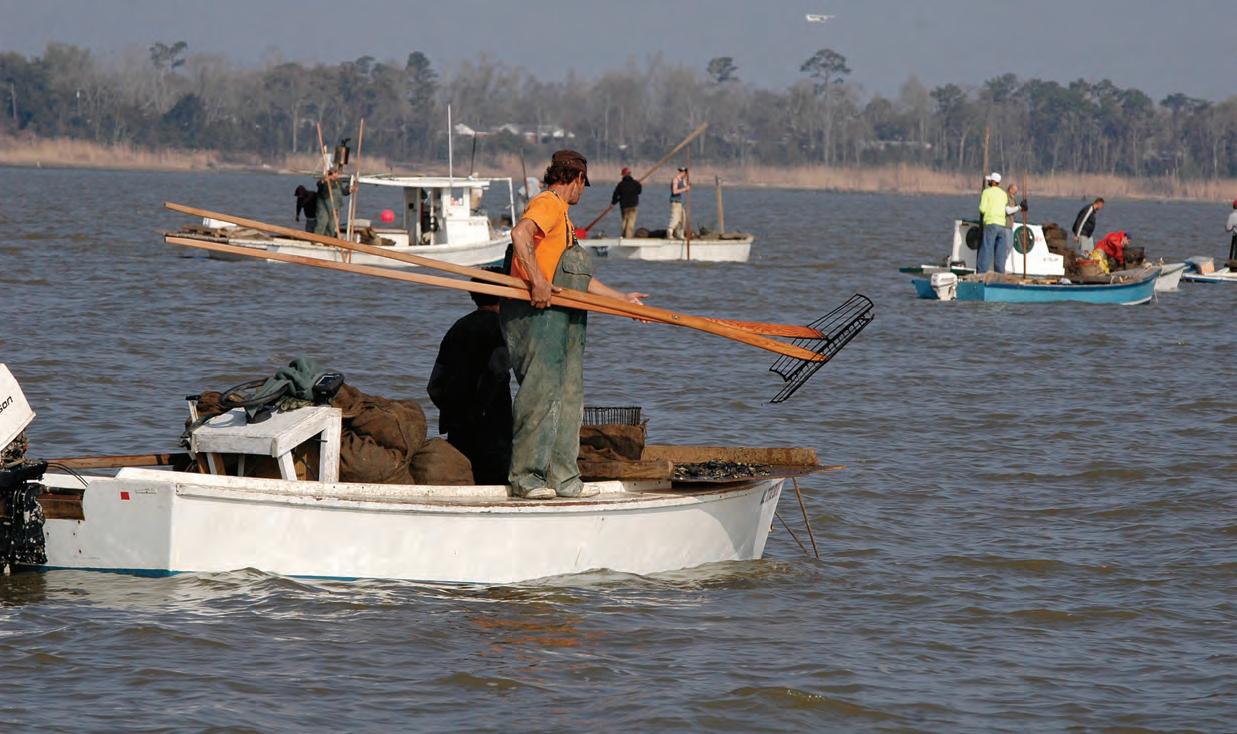
Another goal of the funding is to support and enhance community resilience during environmental or economic crises. The $65 million in projects includes the construction of the Auburn University Gulf Coast Engineering and Research Center in Orange Beach to improve engineering in the coastal environment. Also, a new Alabama Department of Environmental Management (ADEM) office is under construction on the coast. The Alabama Seafood Commission is funded as well as Fairhope’s Working Waterfront and Green Space initiative.
“Resilience is important for all of our state but particularly
our coastal areas,” Blankenship says. “We’re working to make us more resilient during storms or drought or economic downturns, things that make our communities stronger when we have negative impacts in our state.
“As an aside, Governor (Kay) Ivey, by executive order, created a resilience council just a few weeks ago, and the Commissioner of the Department of Conservation is one of the members.”
Funding will also be used to provide and enhance economic development and infrastructure. The 11 projects, totaling $197.5 million, include the construction of Africatown Welcome Center, which will house a portion of the Clotilda. The Clotilda, discovered in the Mobile-Tensaw Delta, was the last slave ship to transport slaves from Africa to the United States. In another key project, the Port of Mobile has constructed a roll-on, roll-off facility that will facilitate the export of cars and trucks that are built in Alabama. Road improvements in Baldwin County are also included in this funding.
About $401 million is being used to restore, conserve and enhance habitat in coastal Alabama.
“This is primarily land acquisition,” Blankenship says. “So far, we have acquired more than 13,000 acres of land in coastal Alabama to protect and provide recreational access. That includes the west end of Dauphin Island, Grand Bay Savanna, Pilot Town on Fort Morgan, Gulf Highlands property on Fort Morgan, which is one of the last undeveloped areas of the beach that was not part of Fort Morgan or the Bon Secour National Wildlife Refuge. It also includes multiple parcels in Weeks Bay, parcels at Dauphin Island, Oyster Bay, and we have purchased three parcels in the Three Rivers area that we have transferred to the Bon Secour National Wildlife Refuge.”
Land acquisition also includes tracts along the Perdido River watershed to provide a wildlife corridor from the Perdido River Wildlife Management Area to the Lillian Swamp Forever Wild property.
“We have been working for the past six years to connect those
Rainer, Alabama Department of Conservation and Natural Resourceswildlife management areas,” he adds. “It will be a distinct wildlife corridor with about 50 miles of river frontage.
“When that work is done, we will have well over 30,000 acres along the Perdido River for public access, hunting, hiking, canoe trails and river frontage from near the headwaters all the way to Perdido Bay in public ownership. We have used more than eight different funding sources to acquire this property. This shows how working together with our divisions and the Deepwater Horizon Section has been really successful at putting all this together for the people of Alabama for perpetuity.”
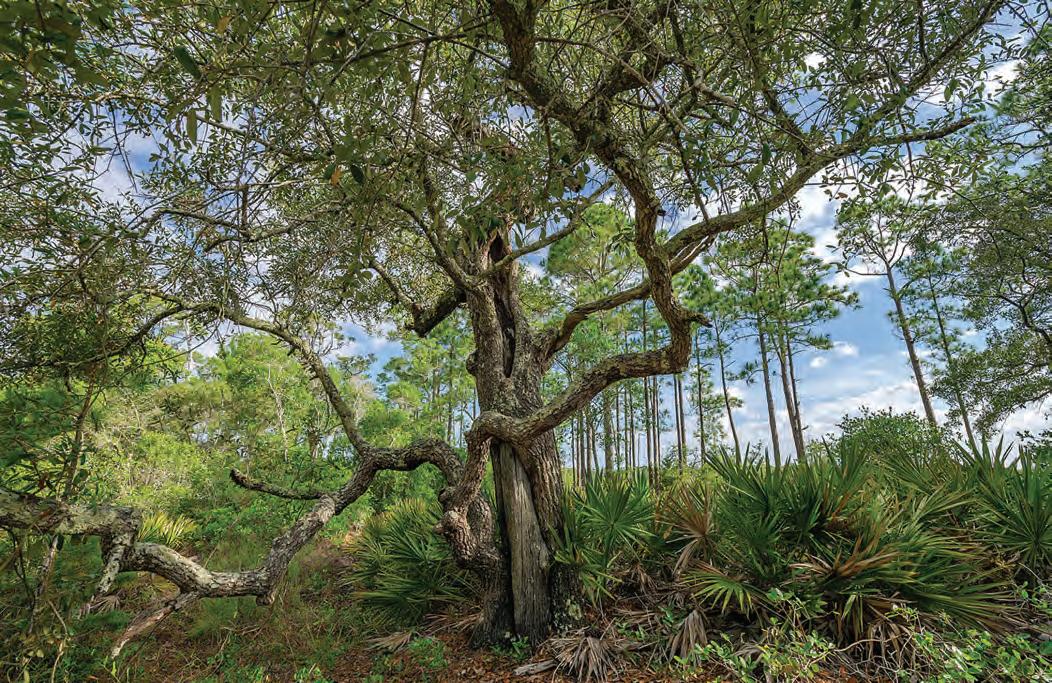
Another $159 million is committed to improving water quality in coastal Alabama through sewer and septic tank mitigation.
“We are working with the utilities to avoid sanitary sewer overflows to improve water quality,” he says. “Using Deepwater Horizon and GOMESA (Gulf of Mexico Energy Security Act) funding, we have done several septic to sewer conversions in the coastal areas, like Fowl River, Grand Bay and Bayou La Batre, that are really close to the water.”
The effort to provide and enhance recreation and public access will receive $147 million in funding.
“During the oil spill, it wasn’t just the environment that was impacted, it was also the people,” Blankenship says. “We lost recreational access to the beaches, fishing and a lot of other activities. As part of the Natural Resource Damage Assessment (NRDA), a large portion is dedicated to recreational use to include projects at our State Parks. Gulf State Park and its 28 miles of trails is probably the most obvious example of that. But we are also expanding the campground at Meaher State Park on Mobile Bay, a trail on Fort Morgan, and blueway and greenway development in the City of Mobile. That also included improvements to Gulf State Park Pier, which was finished just as Hurricane Sally hit. And the Fort Morgan Pier was rebuilt. Scott Bannon and Marine Resources oversaw that construction.”
Commissioner Blankenship said the $39 million in GOMESA funding was received this year and projects will be announced by the Governor this summer. Previously, more than $120 million in GOMESA funding has been used for multiple boating access improvements, land acquisition, other public access for parks
on the water in Mobile, Spanish Fort and Daphne, water quality improvements, environmental research and economic development. Additionally, beach nourishment projects will begin in late summer for Dauphin Island, Gulf Shores, Orange Beach and Gulf State Park.
Several years ago, Governor Ivey created Innovate Alabama, an entity with the goal of attracting people, businesses and manufacturing to the state. Commissioner Blankenship is the chair on that entity’s Council on Outdoor Recreation.
“Innovate Alabama was set up to differentiate us from other states, to attract or retain workers and improve the quality of life in Alabama,” he says. “One of the things that came out of that was outdoor recreation and the beauty of our state.
“We have a lot of woods and water in our state, and that gives us great opportunities for recreational access. It is a way to differentiate us from other states.”
Commissioner Blankenship says the council decided to expand its reach by creating the 19-member Outdoor Recreation Advisory Roundtable to include a variety of recreational activities and geographical areas. Tim Wood of Selma, a Conservation Advisory Board member, also serves on the roundtable.
Construction is under way at many Alabama State Parks across the state, using the funds provided by the bond issue that was overwhelmingly approved by voters last year. He said some areas of the parks may be closed during the construction.
“I tell people, ‘Pardon our progress. Once we get this done, you’re going to be really pleased with the finished project,’” he says. “As part of the renovations of the parks, we hosted a public meeting at Northport for Lake Lurleen State Park to get input from the public about what they wanted to see when we do the renovations at that park. It is going to be pretty much a rebuild at that park. I thought we might have 20 or 30 people show up, but we had more than 100 people show up at the community center to voice their opinions on what they want to see at the park. In fact, they canceled the church service on Wednesday night at the Baptist church so everybody could attend the meeting. We were happy to see so much interest in Lake Lurleen State Park.”
How to sort the many choices in home generators
By Paul WesslundIf you’re wondering whether to buy a home generator in case of a power outage, you’re not alone. Backup power sources have gotten so popular that manufacturers now offer a wide range of choices.
Options run from pull-start gasoline models costing a few hundred dollars to permanent outdoor installations for several thousand dollars. That variety makes it easier to get exactly what you want, but harder to choose.
A good first step is to think about what you want a home generator to do. Do you just want to keep your phone charged? Do you want to make sure food doesn’t spoil in your refrigerator? Do you want to make sure you have heat and air conditioning through an extended outage? Answering those questions will require you to know the wattage of the appliances you want to run so you know the capacity of the generator you need.
You might also ask if you really need a generator. The average U.S. home is without power about seven hours a year. Is that enough to justify the expense and attention?
Another part of your planning should be contacting your electric co-op to get their expert advice on the best and safest fit for your home.
Here’s what to know about the four basic choices in home generators:
Portable generators are small enough that you might even take them on camping trips. The costs for these can vary—from more than $2,000 to as low as $400. Most should be able to run a refrigerator or a window air conditioner. Special attention to safety is required. They should never be used indoors, not even in a garage. The carbon monoxide they produce can be deadly in minutes. The Consumer Product Safety Commission reports that 85 people die each year from carbon monoxide poisoning caused by gasoline-powered portable generators. Portable generators should be operated more than 20 feet from the house and be connected only with outdoor extension cords matched to the wattage being used. Look for models with a carbon monoxide detector and automatic shutoff.
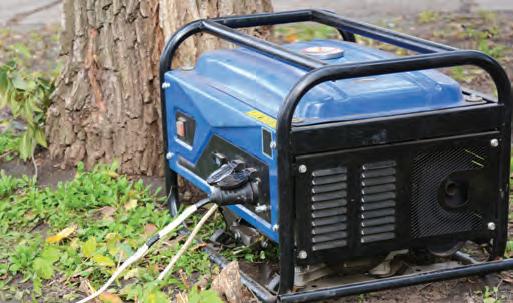
Appliances should be plugged in to the generator—the generator should never be plugged into an outlet or your home’s electrical system.
You should also spend the money to have an electrician install a transfer switch. That acts as a mini-circuit breaker to protect your appliances and can be an easier way to connect the house to the generator.
Inverter generators are higher-tech versions of standard portable generators. The power they produce changes to match what the appliances are using, so although they are a little more expensive, they use fuel more efficiently and make less noise. The same safety guidelines apply to both inverter and standard portable generators.
Standby generators can cost $7,000, plus installation, but they have the benefit of turning on automatically during a power outage and running your whole house. They’re typically a permanently-mounted outdoor unit that’s connected to your home

electrical system and runs on propane or natural gas. It must be installed by a professional electrician.
Power stations, also known as batteries, charge themselves up while the power is on. They’re not as powerful as some of the other options, and can be more expensive, but they’re quiet, easy to operate, and some are designed to look good hanging on the wall. They can cost between $400 and $6,000. One common use of power stations is to pair them with rooftop solar panels so that electricity from the sun can be available even at night.
With the increased intensity of storms and our reliance on electronic devices, power outages can be a bigger concern these days. Technology now gives you many choices for how to react, whether you want to make sure you’re never without power, or you’re willing to just light a candle and wait for the lights to come back on.
Paul Wesslund writes on consumer and cooperative affairs for the National Rural Electric Cooperative Association, the national trade association representing more than 900 local electric cooperatives. From growing suburbs to remote farming communities, electric co-ops serve as engines of economic development for 42 million Americans across 56% of the nation’s landscape.
Most standby generators are permanently mounted outside the home, then connected to the home’s electrical system. Standby generators run on propane or natural gas, and they must be installed by a professional electrician. Photo Source: CanvaGet smart about home lighting
By Abby BerryGone are the days when a simple flip of the switch was the only choice for illuminating our homes. While we still have this tried-and-true option, we’ve entered a new era of innovative and intelligent technologies, which includes smart lighting.
Smart lighting connects to Wi-Fi and offers an array of cutting-edge functionality and convenience. Let’s look at the main benefits of smart lighting options.
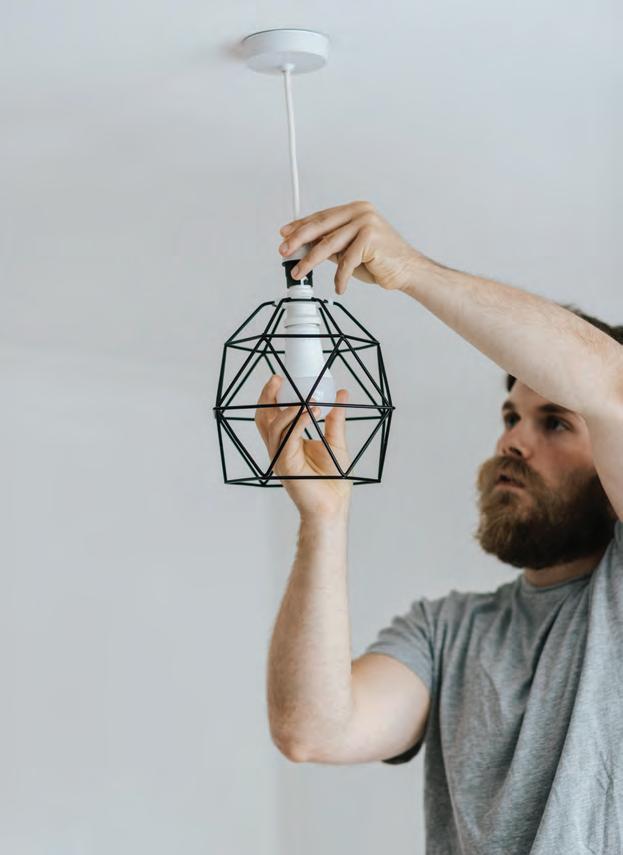
Smart lighting is energy efficient. Most smart bulbs utilize LED technology, which is much more efficient than traditional incandescent lighting. Additionally, smart lighting gives you more control over how and when you light your home, ultimately resulting in less energy used for lighting.
Smart lighting provides convenience and control. Most smart bulbs can be controlled from an app on your smartphone or can be paired with your voice assistant, like Amazon Alexa. You can conveniently control lighting settings from anywhere in your home or when you’re away. Whether you want to set a schedule for lighting or adjust brightness levels, these smart options offer effortless control from the comfort of, well, anywhere!
Smart options empower you to personalize home lighting. Bright, warm, purple, green––whatever mood you want to create, smart lighting can help. For a more traditional look, try dimmable white bulbs. If you want to create the perfect ambiance for movie night, look for bulbs that can be adjusted for a variety of vibrant colors. The possibilities are endless.
While smart lighting offers convenience and control, keep in mind your wall light switch will need to stay “on” for you to control the smart bulb from your phone or via voice command. To use a smart bulb, the wall switch it’s connected to must be “on” so the bulb receives power, which enables it to connect to a Wi-Fi network.
If you need additional options to operate the lights, consider a smart light switch. Today’s smart switches tend to play nicely with smart bulbs. If you want to control your smart bulbs with a physical switch (in addition to using your phone and voice commands), look for smart switches that include a built-in feature that allows both. Many smart light switches include motion detectors as well.
If you’re looking to take the plunge and integrate multiple smart bulbs to your home lighting system, your best bet may be a kit, like the Philips Hue Starter Kit. Most kits include several bulbs and any additional tools you’ll need to get started.
If you’re new to smart home tech and looking to start small, try a smart bulb in a high-traffic area of your home. It’s also worth noting that smart plugs are a great starter option and allow convenient control of lamps or other lighting fixtures that are plugged in to a wall outlet. Smart plugs are inexpensive and simply plug in to your existing outlet. Electrical items that are connected to the smart plug can be controlled from a smart phone app, just like smart bulbs.

Whether you’re looking for more convenience, colorful options or better ways to manage energy use, smart lighting can provide multiple benefits. Determine which smart lighting features are most important for your needs, then start shopping!
Abby Berry writes on consumer and cooperative affairs for the National Rural Electric Cooperative Association, the national trade association representing more than 900 local electric cooperatives. From growing suburbs to remote farming communities, electric co-ops serve as engines of economic development for 42 million Americans across 56% of the nation’s landscape.
HOW SOLAR PANELS WORK WORD SEARCH
Did you know energy from the sun can be used to create electricity? Read the following information about how solar panels work, then find and circle the bolded words in the puzzle.
Solar panels contain photovoltaic cells that convert sunlight into electricity.
Sunlight hits the solar panels and generates a direct current.
The direct current flows to an inverter, which converts it to an alternating current. (This is the kind of electricity we use in our homes.)
The alternating current flows from the inverter to the home’s breaker box, where it’s used to power appliances and electrical devices in your home.
If the solar panels generate more electricity than the home needs, the unused electricity is sent back to the power lines.




Play it safe at the beach this summer
One of the highlights of a beach trip is water recreation. But the Alabama Law Enforcement Agency (ALEA) reminds everyone to be mindful of safety around water this season.
Never swim alone. Stay in groups, and don’t drift too far from shore.
• Don’t swim near piers, pilings and platforms.
• Do not swim in areas being used by fishermen. Avoid swimming in areas where schools of fish are present.
• Use extra caution when water is murky. Avoid being in the water during nighttime hours.

• Rip currents are most prevalent when the waves crash perpendicular to the beach, rather than at an angle. Look for gaps between the waves; a small patch of calm water surrounded by waves is often a rip current. And look for discolored water near the shore. Rip currents tend to drag large amounts of sediment back out to sea; they’re identifiable by a noticeable flow of sand extending away from the shore.
• Heed beach warning flags, which are posted at all public beach areas in Gulf Shores, Orange Beach and Gulf State Park. For more on summer safety, visit alea.gov.

Alabama launches statewide action plan to eliminate cervical cancer by 2033
Alabama ranks third in the nation in the incidence and deaths from cervical cancer, and the burden is even worse in rural counties. To address the problem, the state Department of Public Health, primary care providers and several other health and advocacy groups have launched “Operation Wipe Out Cervical Cancer Alabama.”


The action plan will use evidence-based strategies to promote vaccination against the human papillomavirus (HPV), encourage cervical cancer screenings, and ensure follow ups when a screening indicates abnormal results.
HPV vaccinations help protect children and adolescents before they are exposed to the virus. Cancer screenings among women ages 21 to 65 detect abnormal cells in the cervix, which can lead to cancer. And appropriate follow-ups improve the chance of recovery from cervical cancer.
For more information on the statewide action plan, and to find out how you or your organization may get involved, visit alabamapublichealth.gov
Take us along!


We’ve enjoyed seeing photos from our readers on their travels with Alabama Living! Please send us a photo of you with a copy of the magazine on your travels to: mytravels@alabamaliving. coop. Be sure to include your name, hometown and electric cooperative, and the location of your photo.We’ll draw a winner for the $25 prize each month.
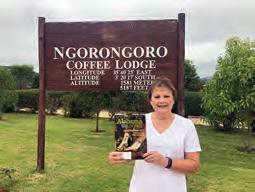



Whereville, AL
Find the hidden dingbat!
The snazzy red convertible hidden as if it was a golf shirt logo on Page 38 of the June issue didn’t fool many of our readers. In fact, Ginger Sebright of Somerville was pleased to find the dingbat because even though it was tiny, she knew the car looked familiar. “We had to find it,” she wrote.
“ That’s our car!” She is a member of Joe Wheeler EMC and their car is a 1979 Fiat spider 124. Jessica Morris of Coffee Springs enjoys looking for the dingbat with her seven-year-old son and 10-year-old daughter. They found the convertible on their second read-through. “They see pointers, horses, fish, whales, and alligators on collared shirt chests, so they thought the car dingbat was a new shirt logo,” writes the Wiregrass EC member. ”We had fun searching (like usual). Good way to keep busy now that school is out for summer.” Getting your kids into the hunt is another way Ada Graham’s Spruce Pine family finds the dingbat. This time, 12-year-old Michael was the first one to find it on his first time looking. They are members of Franklin EC.

Congratulations to our randomly drawn winners Phil & Sheila Bird of Hamilton. This month, we’ve hidden a baseball. Batter up!

Sponsored by
By mail: Find the Dingbat Alabama Living PO Box 244014 Montgomery, AL 36124 By email: dingbat@alabamaliving.comGrant program to benefit state’s historic places

Identify and place this Alabama landmark and you could win $25! Winner is chosen at random from all correct entries. Multiple entries from the same person will be disqualified. Send your answer with your name, address and the name of your rural electric cooperative, if applicable. The winner and answer will be announced in the August issue.
Submit by email: whereville@alabamaliving.coop, or by mail: Whereville, P.O. Box 244014, Montgomery, AL 36124.
Contribute a photo you took for an upcoming issue! Send a photo of an interesting or unusual landmark in Alabama, which must be accessible to the public. A reader whose photo is chosen will also win $25.
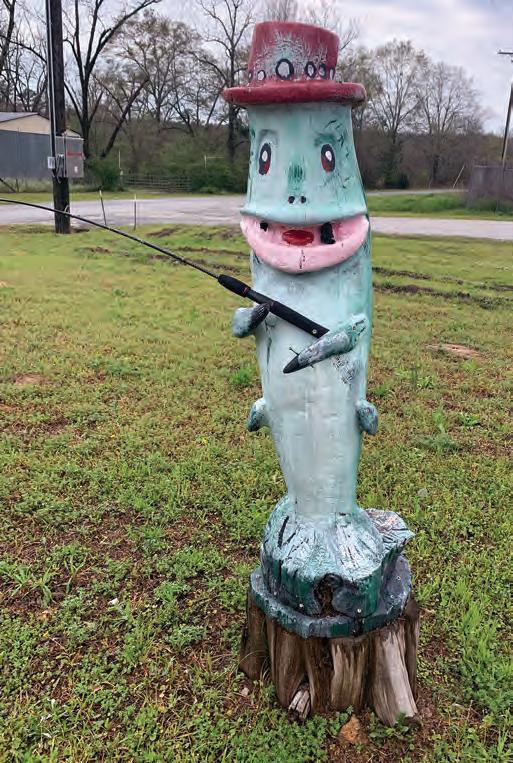
June’s answer: This diminutive building was at one time the Bank of Gainesville, Ala., circa 1835-1840. It was moved to Tuscaloosa in the 1960s and returned to Gainesville by a local benefactor in the 1990s. The bank now occupies its original location adjoining the triangular town park. This is the only remaining commercial structure of the period. The town, perched on a wooded bluff overlooking the Tombigbee River in Sumter County, was a key inland shipping point in the cotton trade. (Information from the Society of Architectural Historians; photo by Allison Law of Alabama Living.) The randomly drawn correct guess winner is Rick Syklawer, Wiregrass EC.
The Alabama Historical Commis sion (AHC) has received $6 million from Gov. Kay Ivey and the Legislature for the Preservation of Alabama’s Significant Sites (PASS) grant program. The program will assist in the preservation and repair of historic sites in Alabama.
Preference will be given to any structure constructed for government or public purposes before 1840 that is listed in the National Register of Historic Places and is owned by a local city, town, county government, or non-profit organization, or any structure built before 1965 that is eligible for or listed in the National Register of Historic Places and significantly contributed to the Civil Rights Movement.
Local and county governments, as well as non-profit organizations, are eligible to apply. Sites receiving grant funds from the National Park Service or receiving state or federal historic tax credits are not eligible for funding. In addition, there is no maximum grant amount and funds will be given to “brick and mortar” projects for the physical preservation of historic sites.
The deadline is July 10, 2023. For more, visit ahc.alabama.gov/ Resources/grants.aspx


The mnemiopsis is a comb jelly – not a true jellyfish, but because of its appearance it often fools people as being a jellyfish.

Jellyfish: the aquatic dinosaur that lives on in our oceans
In a book of Who’s Who of Alabama Animals, jellyfish claim the chapter, “Wonderfully Weird and Occasionally Wicked.” Few creatures pique one’s curiosity, evoke awe, and sting like the dickens, more than Alabama’s glob of distinction.
The Gulf Coast has more than 60 species of jellyfish. Most we never see, but some swim among us. Resembling something from “Star Wars,” nature’s Jell-O has changed little since prehistoric times. It is literally an aquatic dinosaur that survived.
Jellyfish have no brain, heart, or central nervous system. Under those conditions, a human would be dead on arrival, but for jellyfish? No problem.
What makes this animal a living being and not wet Play-Doh? We asked experts who refer to jellyfish as “jellies,” because a jellyfish is not a fish.
“ There are many misconceptions about jellies,” says Dr. Anthony Moss, Auburn University associate professor and marine program coordinator. “Most people think jellies just float around but actually, many on the Alabama coastline are good swimmers.
“Some make sharp turns and maneuver tentacles in a manner that makes it more likely to trap prey - plankton and tiny fish,” he adds.
Most jellyfish swim the way jets fly, through propulsion. They suck water in their bodies and push it out, causing motion.
Pretty impressive for an aquatic existence void of cognitive thought. But what jellyfish lack in brains, they make up in nerves. In fact, we get on their nerves. It’s how they know we are there.
“We are still looking at how jellyfish think,” Dr. Moss says about the gelatinous mystery. “They don’t have a nervous system but they have a nerve bed, distributed through its entire body.
“The cells coordinate muscular contractions and access envi-
ronmental conditions. Jellyfish are much more capable of sensing the environment than we used to think. They sense prey possibly through smell and vibrations in the water.”
And yes, most of Alabama’s memories of jellies are not pleasant. Their stings range from mildly annoying to, in rare cases, hospital care. But if jellyfish could discuss their stings, it would say, “Don’t blame me, blame my tentacles!” They are correct.
As head curator of the Alabama Aquarium at the Dauphin Island Sea Lab, Brian Jones knows jellyfish through research and personal experience. “Oh yeah, I’ve had a few stings in my day,” the curator smiles. He explains the animal’s thought process – or the lack thereof – during stinging.
Touch it, you’re stung
“Jellyfish stinging cells are embedded with tethered harpoons,” Jones says. “The cells are triggered by touch. If you rub against it, you are shot. The sting is a mechanical stimuli reaction. The jellyfish has no say in the matter – its nerve pad does.”
Once the barb is injected, a toxin is pumped through the tethered line into the jelly’s prey – small fish, larva, tiny crustaceans, or collegiate spring breakers. Hence the sting.
The good news is, once deployed, the tentacle / barb can be used only once, just like a honeybee’s stinger. The bad news is, unlike the honeybee’s stinger, a jellyfish has thousands of tentacle barbs, each locked and loaded.
Even if the tentacle is torn off and free floating – touch it, trigger it, you’re stung. Even if the jellyfish is washed ashore and dead, touch the nerve cells, and you are stung.
Fortunately a jellyfish sting typically wanes within an hour. First aid actions vary.
 Head Curator Brian Jones discusses jellyfish with a visitor at the Alabama Aquarium at the Dauphin Island Sea Lab.
PHOTO BY EMMETT BURNETT
Head Curator Brian Jones discusses jellyfish with a visitor at the Alabama Aquarium at the Dauphin Island Sea Lab.
PHOTO BY EMMETT BURNETT
“I find one of the best treatments is first, pull the stinger from your skin. Usually your fingertip’s skin is too tough for the barb to penetrate,” notes Jones. “After the barb is out, submerge the wound in hot water. Heat breaks down the proteins in the venom.”
According to Auburn University, seven jellyfish are common on Alabama’s coastline: the sea nettle, moon jellyfish, cannonball, Portuguese man-of-war, oceanic jelly, sea wasp and mushroom jelly. But among the most common sightings is the comb jelly. It is cute, fascinating, and fake.

“People mistake comb jellies for jellyfish because comb jellies look like jellyfish and have similar lifestyles,” says Jones. “The neat thing about comb jellies (is) if you touch one, it glows bright blue-green. A chemical reaction in their translucent bodies produces light.”
As we gaze into the Alabama Aquarium’s tank filled with comb jellies resembling living lightbulbs, he continues, “People see comb jellies at night in the gulf, by the thousands. They look like stars in the water. It is an amazing sight.”

As for our Gulf Coast stingers, the sea nettle is most common. It grows to four inches in diameter and has 24 tentacles. “Sea nettles eat comb jellies,” says Dr. Moss, “but they have a nasty sting.” Recipients of the nettle’s wrath compare it to a wasp sting.
Moon jellyfish, though intimidating in size, as much as 18 inches in diameter, pack a milder punch. Humans stung note it as an annoying, itchy spot on the skin.
The cannonball jellyfish is so named because it is 10 inches in diameter and shaped like a cannonball. Though mildly venomous, it is mostly a nuisance for shrimp fishermen, clogging their nets.
But the bad boy of Gulf waters is aptly named: Portuguese manof-war. “It has a bad attitude and a terrible sting,” warns Dr. Moss. It can sting through your clothes and can leave a permanent scar.”
The Portuguese man of war’s tentacles never stop growing. Their appendages can be – and this is not a typo – 100 feet long. With tentacles swaying in every direction, a person can be 30 feet or more away from the man of war, and still be stung.
“Babies and people with heart conditions are in the most danger,” warns Dr. Moss. “For most of us, the man-of-war is not life-threatening, but will sting with pain you will never forget.”
If you encounter one – a large purple to blue float, on the water’s surface – run, swim, whatever it takes, get away from it. Fortunately, the Portuguese menace is not as common as other jellyfish.
On the positive side, jellyfish are important to the environment. “Sea turtles love them,” adds Brian Jones. “Many fish eat them too. In addition, lots of jellyfish eat other jellyfish.”
In Asian countries, jellyfish are a delicacy but so far, not that popular here, but could be. There’s always room for Jell-O, but be sure to remove the stinger.
Ed. note: At presstime, the Alabama Aquarium was temporarily closed for renovations but was expected to reopen in early July. Check its website for the latest updates: disl.edu/aquarium

Roanoke never forgot Ella Smith and her “Alabama Indestructible Doll”
By Jim PlottIn a November 1922 newspaper advertisement, just in time for Christmas, the Montgomery Fair department store on Dexter Avenue in downtown Montgomery featured a range of Ella Smith dolls, all for sale priced from $1.25 to $2.75 each.
The dolls, marketed as the “Alabama Indestructible Doll” and made in Roanoke, Alabama, were very popular for decades at the turn of the century and beyond.

Fast forward to February 2022, when an episode of the popular PBS program “Antiques Roadshow” featured two of the dolls which were sold and marketed in their day as the “Alabama Indestructible Doll.” Although the dolls had minor clothing blemishes, they were given an appraised value of between $1,000 and $1,300. The owner, who’d inherited them from her mother whose aunts were the original owners, wasn’t a big fan of the dolls which she described as “terrifyingly hideous.”
Ella Smith might not appre ciate that assessment. Her story dates back to 1897, when Verna Pittman, a young neighbor in Ro anoke, presented her with a broken bisque doll in hopes she could repair it. After some unsuccessful attempts, Smith resorted to her own ingenuity by making a plaster of Paris mold for the head, overlaying it with material and painting the face. It marked the birth of an idea.
Over the next 35 years or so, Smith tirelessly crafted and sold the Alabama Indestructible Doll, constantly making im provements. She was awarded a total of 12 U.S. patents, although not all were related to the dolls. Her dolls earned awards at prestigious events such as the 1904 World’s Exhi bition in St. Louis and the Southeastern Fair in Atlanta.
Smith meticu lously used oilbased paints for the dolls’ facial features, hair,
hands, feet and shoes, and human hair occasionally adorned the dolls. Depending on the year, size and style, doll prices ranged from $1 to $12.
In her catalog, Ella Smith proudly marketed her products as durable and washable “just like children.” She guaranteed “no cheap stuff” was used and they would withstand rough play from children.
“Dolls are to be played with and loved, in the midst of which little hands fumble, a doll is broken, and so is a little heart,” she was quoted as saying by Virginia Brannon Smith, who, as a child met Ella Smith.
Born in Troup County, Georgia, and reared in Langdale, Alabama, Smith received an art degree at LaGrange (G orgia) College. She moved to Roanoke in 1886 where she become an art teacher at Roanoke Normal School. There she married S.S. “Bud” Smith, a local carpenter. Although the Smiths never had any children, they adopted and reared a l and a nephew.
Initially manufacturing dolls om her house, as her business expanded she was able to hire employees and move into an adjacent building constructed r her by her husband. At the peak of the business, she and her employees were producing 8,000 handmade dolls a year including black dolls, which were rarely made at the time, particularly in the South. ese dolls are painted to represent all races of people. We mean to try to please all people as near as we can,” Smith said at the time.
In addition to doll making, Smith exp lo red

other ventures, including painting, photography and inventions other than doll making.
The Randolph County newspaper, The Randolph Leader, described her as a woman of “opposites.”
“She was a tremendous woman … simple but touched with genius, great-hearted but bluntly plain spoken, generous to her own hurt, devoted to children, but often overly harsh. Sometimes it was easier to tell what she was not rather than what she was,” the newspaper wrote in 1957.
Unpredictable, perhaps, but what is certain is that Smith boldly dared to step into a man’s world years before women acquired the right to vote. At the same time, she often referred to herself as Mrs. S.S. Smith.
Tragedy struck unexpectedly. In 1922, during a return sales trip to New York City, two of her doll salesmen were killed in a train wreck. The family of one successfully sued Smith, nearly bankrupting her.
Consequently, she closed the factory, released her employees and resumed doll making in the house. She rarely ventured out and seldom engaged in going to the movies – once a favorite pastime.
While her dolls might have been indestructible, Ella Smith wasn’t. Ailing with diabetes and Bright’s disease, a kidney affliction, and what many say was a broken spirit, Smith died in 1932. She was buried in the local cemetery just blocks from her house.
In the 1990s, a series of postage stamps commemorating American dolls, including the Ella Smith Doll, prompted the city of Roanoke to honor one of its most famous citizens with doll shows and other events. Over time, even that annual ceremony waned.
Except for a welcome sign on the south entrance to the city proclaiming Roanoke as the home to the Ella Smith Doll, there is not much indication in the city of her or the dolls’ existence. The Doll Factory behind the house has become dilapidated and parts of it,
concealed by thick brush, are falling in.
These days, most of the dolls are owned by private collectors. The Alabama Department of Archives and History has several Ella Smith dolls in storage and the Museum of East Alabama in Opelika has several of the dolls on display.

Her Main Street home still stands and is now a law office. Attorney John Tinney, however, felt it fitting to let several upstairs wall hooks, used by Smith in the doll-making process, remain in place. Locals, like Dorothy Tidwell, executive director of the Randolph County Chamber of Commerce, say they are still aware and proud of Smith’s accomplishments. There is an ongoing drive to rejuvenate the Randolph County Museum in the old post office and have an Ella Smith exhibit.

“We haven’t forgotten Ella Smith and her dolls,” Tidwell, also a museum board member, says.

While Smith’s dolls these days are often viewed as “creepy” by newer generations who grew up with more life-like dolls, there is no disputing her contribution to the doll industry or her place in American life, according to appraiser Billye Harris, who owns Ashley Dolls and Antiques in Whitsett, North Carolina, and who was the appraiser on the “Antiques Roadshow” segment.
While Ella Smith dolls might have been valued at a higher price in the past, the doll market overall has seen a decline in values in recent years, Harris says.

“I believe this is because of the birth of internet sales and antique dolls are more easily found. The majority of antiques in general have seen a decrease in value over recent years, but I feel that is about to make a slow but sure turnaround.”
She’s a fan of the unique dolls made in Alabama. “Ella Smith and her dolls are an important part of doll history,” Harris said. “Her dolls represent how a woman in times that most women did not work outside the home was able to engineer, create and market her dolls.”

Enterprise restaurant is ‘a family tradition, yours and ours’
If you visit Enterprise, folks will make sure two things are on your to-do list: Seeing the Boll Weevil Monument downtown and eating a meal at Cutts Restaurant. And that’s just fine with the Cutts family, who’s owned the restaurant for more than 60 years. “So many families have grown up here, that they’ll come (back) in from Timbuktu or somewhere and they’ll call their parents and say, ‘We’ve got to go eat at Cutts,’” says Rick Cutts, who worked at the restaurant growing up, and then owned and managed it for 30 years.

His grandparents, Hubert and Pearlie Bell Cutts, along with his parents Larry and Ellen Cutts, started the business in 1967 as a country grocery in Level Plains selling chili dogs. “They came up with a chili recipe which is still a family secret,” he says. When business got too big for that location (a former Phillips 66 station), they moved it to another Phillips 66 station and expanded the menu to include hamburgers, hot dogs and barbecue sandwiches for lunch only.
They moved to the Enterprise location in 1974, “and when my grandparents got ready to retire, my daddy bought them out in 1980,” says Rick. “The original restaurant was the whole kitchen and you came in from the back door. In 1988, Daddy added this (the current restaurant dining area that has a cafeteria-type line to serve country cooking). That wall was the back door and it was just a snack bar. On Saturdays, we go back to that. It’s our retro day.”
After his dad suffered a stroke in 1991, Rick bought the restaurant from him rather than allowing anyone from outside the family to take over. “Really, never dreaming it would blow up like it has,” he says, referring to the restaurant’s huge following. He was, and still is, an independent insurance agent by trade, but he soon found himself and his family growing the restaurant over the years, adding catering for local businesses and organizations, and

“it’s just become an icon in this area.”
Their motto, “A family tradition, yours and ours,” is proudly proclaimed on a sign in their dining room, where patrons start lining up for lunch at 10:30 a.m.
But the current owner and chef, Ashton Cutts, arrives way before that, starting the day’s cooking and prepping between 4:40 and 5 a.m. Ashton, Rick’s nephew, bought the restaurant from his uncle in April 2021. After 30 years, Rick was ready to retire and wanted to keep it in the family. His nephew, who’d worked in the restaurant growing up as did many of the Cutts children, was the ideal choice. “I’ve been extremely proud of him,” says Rick. “He grew up cooking with my mother who was the best cook in the world.”
Ashton, who’d retired from the Army and earned degrees in HVAC and building trades, was eager to take the job. “I started cooking with my dad, hanging out in the kitchen with my grandmother,” he recalls. Most of the recipes are hers, including those for the restaurant’s dressing, mashed potatoes, barbecue sauce, and of course, the famous chili dog sauce.
“The way we cook the turnips, butter beans and all the vegetables was how she did it,” Rick adds. And that means from scratch (no instant potatoes) and dessert pies handmade by a family member who’s been baking them every morning for 40 years.
The country cooking fare features 14 vegetables and four meats, Monday through Friday. Each day is something different, from spaghetti to pork chops to brisket, but the mainstays that are always available are barbecue, chicken fingers and fried chicken. Veggies include black-eyed peas, creamed corn, loaded potato casserole, brussels sprouts, butter beans, macaroni and cheese, turnip greens and more. In a week, they’ll feed 3,500 people or about 4,000 meals.
Don’t want a full plate? Head to the front counter and order

from the short order menu of chili dogs, burgers, wraps and Ashton’s specialty, the Alabama Lobster Roll.
“There’s no lobster in it,” says Ashton, chuckling. “It’s barbecue on a hot dog bun, covered in cheese, pickles, coleslaw and both barbecue sauces.” He created the dish when a TV news crew asked him to make them something special “and it was the only thing I could think of.” The name was in honor of a friend from up north.
Famous all over
Cutts gets a lot of traffic from families headed to the Gulf Coast beaches, many of whom see the positive reviews on Trip Advisor. “A lot of people have a tradition to stop here on the way to the beach,” Ashton says. “They buy the merchandise and see what new things we’ve got. I ship barbecue sauce and the hats everywhere. I’ve shipped chili dogs – hot dogs, the sauce, buns and all – to Alaska, and barbecue sauce to a hockey player in Canada, with hats and pepper sauce.” A man in Arizona ordered 32 bottles of barbecue sauce, and a few months later he wanted more, so he drove to Enterprise to buy them.
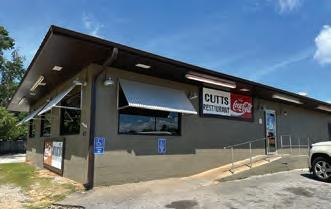
The chili dog landed Cutts on the State Tourism Department’s list of “100 Dishes to Eat” in Alabama.

In addition to running the restaurant, Ashton stays busy with the catering business and can feed up to 300 people. At Thanksgiving time, they sell between 500 and 700 half gallons of their

famous dressing so customers can bake it in their own kitchens, along with turkey breast and ham.

During the Covid shutdown, the restaurant was closed only 2 weeks, and then ran a homemade drive-through for take-out orders out of their back door, Rick says. “We had a tent set up, Ashton manned the tent and rang ‘em up right there. It was hard but we got through it.”

The Cutts name grabs attention, even hundreds of miles away. Several years ago, Rick was wearing his Cutts cap while vacationing in San Francisco. A man kept looking at him, and finally came up to him and asked, “Are you familiar with that restaurant? I’ve eaten there several times.” Rick told him yes, he was the owner. Turns out the man was an Atlanta-based clothing salesman who called on a customer in downtown Enterprise who would bring him to Cutts when he was in town.
Ashton got the same reaction in Birmingham earlier this year at a hotel bar. “A guy sitting next to me started telling people from Chicago I was famous,” he said, smiling. Misti Cutts Dixon, Rick’s daughter, recently returned from Disneyworld where her husband wore his Cutts cap. “We were on the Disney bus and a lady sitting in front of us asked us if we were familiar with the restaurant,” she says. The lady turned out to be from Troy.
Small world, yes. But one that Cutts is happy to be a part of. “The restaurant has become part of the community,” says Rick. “We’re extremely blessed for it to be that way.”
Clockwise, Cutts has been in its Enterprise location since 1974; the lunchtime crowd starts arriving at 10:30 a.m.; former owner Rick Cutts, left, and nephew, current owner Ashton Cutts; Maddy Cutts holds photo of her dad, Ashton, working behind the counter in the same location when he was about her age; Traci Waggoner is ready to serve customers from the extensive selection of meats and vegetables.


Family restaurant’s hot dogs inspired her children’s books
By Lenore VickreyWhen Misti Cutts Dixon was in 6th grade in Enterprise in 2000, a local radio station was publicizing a contest by Scholastic Magazine and the popular group NSYNC to promote literacy.
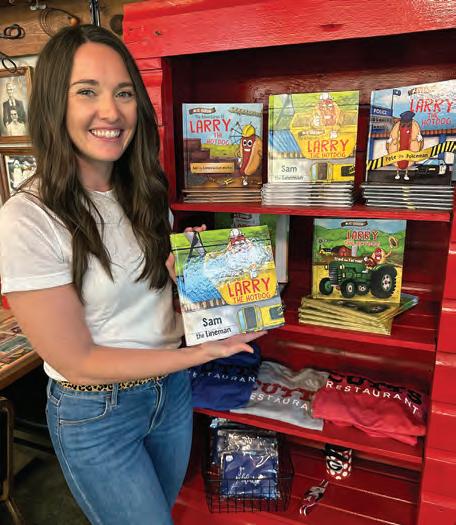
“They wanted people to write in about why you enjoyed reading,” she recalls. The top prize would be a library of new books for the winner’s school.
Intrigued, she wrote an essay and sent it in. “Back then you had to listen to the radio,” she says, “and I learned I’d won the contest for my school!” A special perk was that her school wound up having the town’s only copy of the new Harry Potter book. Misti’s picture was in the local paper.
“Ever since then, I’ve been good at reading, writing and numbers,” says Misti. But her father (Rick Cutts, then owner of Cutts Restaurant, featured on previous page), being practical, advised her to go to school and get an accounting degree.
So, Misti did that, graduating from Troy University with a bachelor’s and master’s degree in accounting and then working in the accounting field, eventually at Wiregrass Electric Cooperative where she has been an accountant for the past nine years. Along the way, she married her husband Lance Dixon, a certified electronics technician who built his own biomed company, Precision-Med Biomedical Solutions, covering the Southeast. Working in the cooperative field as well as the biomed industry, they soon realized how difficult it was to find employees with the needed skills and experience in technical areas to fill jobs previously held by people who were retiring.
Together, they began to brainstorm and came up with the idea of creating a children’s book that could introduce young readers to the value of technical and skilled careers at an early age. “Growing up and working in the family restaurant, behind the register or behind the serving line, I would see people in different uniforms and outfits coming in to eat, and I would think to myself, what are these people doing, what is their career?” Misti says.
Thus began The Adventures of Larry the Hot Dog, inspired by her experiences in the restaurant serving the famous hot dogs, and named after her grandfather, Larry Cutts, who ran the eatery in the 1980s.
Larry is the star of the series of five books, each carrying the magical character on an adventure with friends in different ca-
reers. The first was Karl the Construction Worker, followed by Pete the Policeman, Sam the Lineman, Gary the Garbage Man and Fred the Farmer, her best seller that highlights local crops from the Wiregrass area.
Misti, using the name M.C. Dixon, began writing the books after her son, now 6, was born. She woke up at 4 a.m. to feed her new baby and began writing the books in her head, then finally on paper. “I’m one of those people who constantly needs something to do, so I guess working fulltime wasn’t enough,” she joked.
The books were illustrated by 1000 Storybooks, and are published by Lucky Thirteen Publishing LLC, a publishing company Misti founded and established on her own. The books are sold on Amazon and at Target, Barnes & Noble and Books-A-Million, as well as at local book signings and special events. Misti even designed her very own stuffed Larry, who accompanies her to book events, where she speaks to children about careers, having big dreams, setting goals and working hard to achieve their goals.
She has another line of books, a series of romance novels written as Nicole Dixon (Nicole is her middle name). “I am exclusive to Amazon and Kindle Unlimited,” she says. “I have so many e-readers it’s easier for me to make them available that way.” She works with the same designers to select the book cover models, fonts and other design features, and publishes the novels under the same publishing company. Paperback versions are also available on her website and at Cutts Restaurant on the merchandise shelf with the Larry books, Cutts T-shirts and exclusive baseball caps.
She continues to get up before dawn every morning, typing her latest book on her Nova Lenovo Yoga laptop. Her 10th romance novel will be released this summer.
The writing gene is already making its appearance in the younger generation, as Misti’s 10-year-old daughter, Guilianna, has co-written (as G.R. Dixon) with her mother a spinoff series featuring one of Larry’s friends, Daisy the Donut, who visits more friends at their different workplaces.
“We’ve gone through the whole writing process together,” Misti says proudly. “All five books have been written and edited. The first book should be ready by Christmas.”
For more information, visit nicoledixonauthor.com and follow her on Facebook at M.C. Dixon, Author.

Discovering Alabama’s early history
Raised in a middle-income family in Fairhope, Dr. Ashley Dumas felt compelled to pursue a college degree that would guarantee a stable job and career. However, after getting a sample of archaeology under Dr. Gregory Waselkof while at the University of South Alabama, she heeded the advice of her aunt, a high school guidance counselor, who suggested she pursue her passion and things would work out. As a result, she obtained a degree in anthropology and French from USA, then went on to the University of Alabama to earn both her master’s and doctorate in anthropology. In 2009 she was hired at the University of West Alabama in Livingston to help with the school’s Center for Study of the Black Belt, but her duties expanded to include the studies of the late prehistory and history of the Southeastern United States. She is also the director of the UWA-owned Fort Tombecbe Archaeological site, a French and later Spanish and English outpost on the Tombigbee River.

A few years ago, a Dumas-led archaeological team in west Alabama unexpectedly found European-made arti facts dating to the time of the Spanish explorer Hernando De Soto’s expedition in the Southeast United States around 1540. The discovery also suggests that the excavation site could be in the vicinity of Mabila, a fortified In dian village during which forces of De Soto and Chief Tascalusa engaged in an epic battle. A reported 2,500 Indians died in the engagement and while the Spanish losses in men were few, the battle essentially derailed the gold-search ing expedition, and injuries suffered by De Soto resulted in his later death.

Historians and archaeologists have primar ily relied on three journals written by those on the expedition and another based on in terviews to retrace De Soto’s path from Flor ida through the Southeast U.S. Despite that, Mabila has never been found and suspected locations vary over a wide area of west and southwest Alabama. – Jim
PlottYour archaeological excavations uncovered Spanish artifacts dating back to the time of the De Soto Expedition in the 1540s. Is that an indication you might have discovered Mabila?
We don’t have the battle site of Mabila, but we have found what we think is the chiefdom of Tascalusa so that is important to distinguish. We believe we have a 16th-century chiefdom in the location that matches the 16th-century Spanish chronicles. But we are still looking for Mabila.
What types of artifacts have you uncovered?
We have found a lot of 16th-century na tive pottery (based on the way it is made and decorated). The location of this pottery tells us we have several clusters of farms within shouting distance of one another.
We also now have over 100 pieces of 16th-century European objects. We have
fragments of late medieval horseshoes, iron celts or chisels that were probably used as trade items and fragments of brass candlesticks. All the objects are really obvious in the way they are made that they are from that period. Finding 16th-century metal was a huge surprise, but it has fallen into line with the belief that we have the chiefdom.
What is significant about Mabila and the battle?
The Battle of Mabila was a turning point in the colonization of eastern North America. It was the beginning of the end for the De Soto expedition. De Soto believed he could conquer this area as the Inca (in South America) had been conquered. But by the time he made it to present-day Alabama he had little to show in terms of the mineral wealth he was seeking. He had not been able to pacify the indigenous people as he intended. It sounds hyperbole, but if they had succeeded some people k we would all be speaking Spanish today.
You have said that Mabila is as important as Jamestown and St. Augustine. How important would it e in terms of Alabama and American history to find the Mabila? It would be critically important. It would be considered a sacred site for native peoples even though it was (a victory that took a devastating toll). The Spanish won the battle, but they lost the war because of the fierce resistance. It is a legendary place in Alabama history, d it just makes for a good story. The expedition lost basically all their supplies in the fire that consumed the town. So the expedition was struggling after that. They were not able to conquer this region, and as a result there e no other substantial attempts by Europeans to settle in what is now North America for another 150 years.
What little known fact about Alabama’s early inhabitants do you think is important for peo-
hink it is important that people understand that Indians of this period were not simplistic. They had complex social and political lives and religious beliefs. On the other hand, they were farmers and probably had the same concern about crops of farmers today. They were not monolithic; they were diverse. There were multiple ethnicities and multiple languages spoken s the Southeast and Alabama.

Social Security celebrates the Americans with Disabilities Act

This year, we celebrate 33 years of the Americans with Disabilities Act (ADA) and its importance to many beneficiaries. We’re committed to the principles and spirit of the ADA, and the way it improves the lives of millions. Matt’s story is an example of how the ADA and our Ticket to Work (Ticket) Program can help beneficiaries achieve their career goals.
As a job seeker who is deaf and needs accommodations, Matt was reluctant to tell prospective employers about his disability. He worried that employers would not hire him if they knew about his disability.
That’s when Matt connected with our Ticket Program. This program supports career development for people ages 18 to 64 who receive Social Security disability benefits and want to work. Through this free and voluntary program, approved service pro-
viders offer supports and services as participants move toward financial independence through work.
Matt learned how his employment might affect his benefits. He also learned that our Medicare-related work incentive allows him to pursue a career without worrying about health care coverage.
If Matt’s disability interfered with work, he could return to receiving benefits without having to file a new application through the expedited reinstatement process.
Matt now works full-time as a human resource analyst. Thanks to the ADA, he received accommodations for the interview process and on the job. He also found that the Ticket Program helped him find a path to a better future. You can learn more about the Ticket Program at choosework.ssa.gov
Our online booklet, Your Ticket to Work: What You Need to Know to Keep it Working for You, found at ssa.gov/pubs/EN05-10062.pdf, provides detailed information about the program.
You can learn more about Matt’s story at choosework.ssa.gov/ library/matt-success-story.

Please share these resources with your loved ones.
by Myles Mellor
5 Airport named after Ens. Clarence Moore ____ Jr, the first WWII casualty from Montgomery
6 __ Prado, Spanish art museum
7 Space org, with a base in Huntsville
8 The core of the US Army’s missile and rocket programs, _____ Arsenal
13 Battleship which sailed into Tokyo for the formal surrender ceremonies at the end of WW II
14 Alabama airport which serves as home for the F-16 Fighting Falcons
17 Marine Corps general during WW II born in Hatchechubbee, Russell County, Holland
19 Army depot at the foot of the Appalachian Mountains
Around Alabama
18 Pell City the Pell City Historical Society will host Andrew Eden, who will make a presentation on the Battles of Chickamauga and Chattanooga and the founding of the nation’s first national military park. Free. 1 p.m. at the Venue on 20th. See the group’s Facebook page.
21-30 Northwest Alabama
W.C. Handy Music Festival. This ten-day series of primarily music events around the Shoals area honors the musical legacy of W.C. Handy, known as the “father of the Blues,” and the talented musicians who hail from the Shoals or who recorded there. Wchandymusicfestival.com
JULY
2 and 4 Prattville Independence Day activities. On Sunday, a patriotic concert by the Prattville Pops and Community Chorus begins at 3 p.m. at the Doster Center. On Tuesday, a parade begins at 9 a.m. downtown, followed by the Lions Club barbecue until 2 p.m. at Pratt Park. Cardboard boat races at 10:30 a.m., with a pool party from 1 to 5 p.m. Fireworks at the Clocktower begin at dark. PrattvilleAl.gov
3 Alexander City 19th annual Celebrate Freedom Christian concert and fireworks show, on the front lawn of Benjamin Russell High School at 6 p.m. Musical artists will be Jason Crabb and Colton Dixon, with Christian comedian Mickey Bell. Free; bring lawn chairs. Food available for purchase on site. Sponsored by the Alabama Cross Road Events.
3 Opelika Freedom Celebration, 6:30 p.m. to 9:30 p.m. at Opelika High School, 1700 LaFayette Parkway. Silver Wings Parachute Team, music, hamburgers, hot dogs, popcorn and activities for the whole family. Fireworks show begins at 9 p.m. Opelika-al.gov
3-4 Grand Bay Grand Bay Watermelon Festival, 10327 Taylor F. Harper Blvd. Arts and crafts vendors, food court and entertainment area. On Monday, gates are open 3 to 7 p.m. with no admission. On Tuesday, gates open from 10 a.m. to 6 p.m.; $5 per vehicle admission. Open car show, pretty baby contest, free sliced ice-cold watermelon, rides, games, contests and more. Fireworks at 8 p.m. Tuesday. GrandBayWatermelonFestival.org
4 Cullman Fourth of July fireworks and music festival at Smith Lake Park, 9 a.m. to 9 p.m. Food and arts and crafts vendors; park has tent camping and cabins. CullmanCountyParks.com
4 Fairhope Fourth of July concert and fireworks display, Henry George Park and

the Fairhope Municipal Pier. Baldwin Pops Band concert begins at 7:30 p.m. at the park, with fireworks around 9 p.m. 251-929-1474.
4 Gulf Shores Independence Day Celebration, Gulf State Park Fishing and Education Pier. Fireworks begin at 9 p.m. (Pier closes to the public beginning at 7 a.m. to setup for fireworks.) GulfShoresAl.gov
4 Headland Fourth of July parade and fireworks. Fun on the square begins at 4 p.m., and the ag parade begins at 5 p.m. Fireworks show at Douglas Park begins at 8:30 p.m. Food trucks, glitter tattoos, balloon animals and more. Business.headlandal.org and click on “events.”
4 Henagar 41st Annual Sand Mountain Potato Festival, Henagar City Park. Parade begins at 10 a.m. with activities in the park following. Free entry. Festival includes musical entertainment, car show, craft vendors, food vendors, and game vendors. Fireworks display at 9 p.m. 256-657-6282.
15 Wetumpka River and Blues Music and Arts Festival, 4 to 11 p.m. in downtown. Featuring Chubby Carrier and the Bayou Swamp Band, Jukebox Brass Band, Kat Riggins, the Green Springs and the Fabulous Fliptones. Vendors selling handmade art and food vendors on site. Search for the event’s Facebook page.
15-16 Cullman 16th annual Shoot for a Cure 3D archery tournament at Camp David, 3735 County Road 940. Sponsored by Circle of Hope, all proceeds go to the Bruno Cancer Center. Family atmosphere with door prizes and concessions available; awards will be given for age divisions and levels of competition. Search for Circle of Hope Cullman on Facebook.
22 Clanton 13th annual Chilton County Arts Festival, 9 a.m. to 3 p.m. at the Clanton Performing Arts Center on the campus of Jefferson State. Vendors will sell only hand-crafted art at this free indoor event. ChiltonCountyArtsCouncil.com or call 205990-9409.
27-30 Mobile Gulf Coast Ethnic and Heritage Jazz Festival. Events include an evening of poetry at the Ben May Main Library, a jazz gala, and concerts on the Mobile Civic Center Grounds. Musicians will include Kent Jordan and friends, Excelsior Band and Zulu Tramps, Donald Harrison, Thad Wilson, Madoca and friends and Kim Scott. Gcehjazzfest.wordpress.com
29 Daphne Taste of the Eastern Shore, a fundraiser benefiting the Daphne High School Band. 6 to 10 p.m., Daphne Civic Center. Multiple locally owned restaurants will be featured, along with a silent auction and live music by the Velcro Pygmies. Tickets are $50 per person; email susiepooh1979@yahoo.com
AUGUST
3-6
Northeast Alabama the World’s Longest Yard Sale. More than 650 miles of yard sales and unique treasure finds await travelers along the Lookout Mountain Parkway from Gadsden to Chattanooga, Tenn. VisitLookoutMountain.com
18-19 Russellville Franklin County Watermelon Festival. 5:45 to 10 p.m. Friday and 10 a.m. to 10 p.m. Saturday. Watermelon cutting and contests and fun for the whole family. Music acts on the main stage are Tremayne and Velcro Pygmies on Friday and REWIND, Austin Bohannon and Colt Ford on Saturday. Franklincountychamber.org
To place an event, e-mail events@alabamaliving.coop. or visit www.alabamaliving.coop. You can also mail to Events Calendar, P.O. Box 244014, Montgomery, AL 36124; Each submission must include a contact name and phone number. Deadline is two months prior to issue date. We regret that we cannot publish every event due to space limitations. Alabama Living on FBAlabama Living on Twitter @Alabama_Living instagram.com/alabamaliving
Drugs for pets have their place in a vet’s toolbox

Are all drugs bad? The answer is neither a simple “bad” nor “harmful.” Pharmaceuticals are important tools in the veterinary toolbox.
We get quite a few clients who are suspicious, distrustful, skeptical, and anxious about giving their pets pharmaceutical medications. For example, we had a client who came to see us from an hour and a half away because her local vet gave her “too much” antibiotics for a hot spot on her dog. We have also gotten a few texts inquiring about our opinions on the “dirty” pharmaceutical industries.
For nervous pets, we recommend taking some premedications home before the vet visit, or any stressful procedures like blood draw. While most clients are open to this suggestion, some reject sedatives and prefer to proceed without them. Additionally, a lot of anxious dogs do not get treated because owners are reluctant to give antipsychotic drugs, either because they fear a personality change in the pet or that the pet will be sleepy all the time.
So what do we do? It is an ongoing issue for us, as quite a few clients come to us because we are “holistic.” Many of these folks come to us from hours away. We cannot just tell them that “this is the way we do things, take it or leave it.” They deserve better. They deserve to be heard.
The whole situation is complicated. In the case of the dog with the hot spot, the antibiotics prescribed were within the recommended dose range for those antibiotics, though it was at the higher end. I know of some professors who believe that some skin infections do not get resolved because we do not give antibiotics at high enough dosage for a long enough time. If trained by this professor, the vet was doing right by what they believed. Nothing wrong at all within the scope of proper medicine.
I do understand the general discomfort about pharmaceuticals
after the opioid crisis (where both the pharmaceutical industry and the prescriber have played less-than-ethical roles). Another glaring example is Vioxx, a painkiller made by Merck Pharmaceuticals for about six years in the late 1990s and early 2000s. Merck withdrew the drug in 2004 and paid billions to end thousands of lawsuits by patients who alleged the drug caused heart attacks and strokes.
But on the other hand, I am in awe of the human ingenuity in creating these magical chemicals (medications) that can do miraculous things. I tell clients (tongue in cheek), I love drugs! There is beautiful chemistry behind them. I also love herbs, acupuncture, and so on and so forth.
So, when should we use “drugs” versus herbs, chiropractic, acupuncture, or reiki? This is not an easy call! Ultimately it is a simple matter of checks and balances. In a 14-year-old dog, I would worry a whole lot less about the long-term side effects of pain medications versus the quality of life. In the case of a 3-year-old dog, I would like to seek other ways to help.
As vets, we are like all others with our strong opinions. But as professionals, we are also aware of your value to our business, and we are willing to sit down and talk to you. Find a vet near you who will listen to you. Sometimes you may have to look around to find the right veterinarian for you; this is no different for your personal physician.
After all, it is your pet and we are here to help you. It is our job to discuss the possibilities and let you make the final decision. Find a vet who will suit you.
On a related note: Ask Dr. Google as many questions as you want. I like to see a client who has spent a good bit of time researching and learning about their pet’s health. Honestly, Dr. Google knows way more than I will ever know. This Dr. G has access to pretty much all of human knowledge, and none of us will ever come close. However, where we can shine will be to add wisdom to the knowledge.
I see a good bit of chronic cases where I don’t expect to “cure” them, but I offer clients that I can go on this journey with them and do my best without causing any harm. We all need to walk together and that’s the best that we all can do!



Summer school in the garden: A DIY extravaganza
“Private” gardens
Supplies:
• A small plot in the yard or a large unbreakable pot or container
• A trowel and other kid-friendly gardening tools (nothing too sharp if they are young)
• Seeds or transplants
• Small garden-related figurines, pretty rocks and other embellishments
Directions:
Help each child plan what they want to grow; consider letting them pick a focus, such as edible or flowering plants, and/or a theme, like fairy tales or favorite cartoon characters or shows. Gather appropriate supplies then set them loose to dig, plant and create. Put them in charge of watering and tending their creation.
Seed-starting/rooting 101
Supplies:
Summertime is not only a busy time in the garden – it’s often a crazy-busy time for all the parents, grandparents and caregivers who are trying to keep out-of-school kiddos busy and engaged. Luckily, it’s possible to combine the two.

Gardens are fabulous outdoor “classrooms” where all of us, regardless of age, can learn about and from the natural world. Gardens also provide opportunities to build school-worthy skills in such “academic” areas as math, science, social studies, history, language, art and even fitness. In addition, gardens are the perfect place to acquire and hone important life skills such as responsibility, respect (of self and others), teamwork and patience.
Granted, the idea of setting a band of wound-up children loose in our well-tended gardens is a bit nerve-wracking, but most of our concerns can be mitigated by combining a healthy dose of prior planning with a few fun, easy projects, a wealth of which (suitable for all ages, including adults) can be found online and in myriad books and magazines.
After years of summers spent with my own grandchildren, now ages 2 to 12, I’ve developed a long list of activities and projects (ideas borrowed and adapted from much more inventive minds than my own) that don’t break my budget or back or test my patience. (I sure don’t want to tarnish my grandmotherly halo!) Here are a few of the easiest.
“Found art” garden collages/ shadow boxes
Supplies:
• Craft glue
• Repurposed cardboard boxes or panels or posterboard
• Flowers, stems, moss, acorns, pinecones, etc. gathered from the yard and garden
• Pencils, markers, paints and other art and craft supplies as desired
Directions:
Take the kids on a scavenger hunt to collect natural objects (see above for ideas) then sit them down in a shady spot and let them glue and decorate their discoveries into works of art.
• New or used seedling trays or small transplant pots; repurposed egg cartons, toilet paper rolls, small boxes, etc.; or mason jar or other clear glass container (Google “DIY seed starter pots” for more ideas.)
• Seed starter potting soil/media
• Seeds or cuttings
Directions:
Prepare containers (you may want to wash repurposed items) and fill with potting media or water if you’re rooting new plants from clippings or kitchen scraps like potatoes, carrots and avocado seeds. Plant seeds or suspend cuttings in containers. Gently water potting media until well moistened but not soaked and place containers in a spot with the appropriate amount of light, which will depend on plant you’re growing. Watch them sprout.
“You rock” garden art
Supplies:
• Rocks of any shape and size but usually easier if they have smooth surfaces
• Acr ylic paints and markers or permanent marker pens
• Other art and craft supplies, as desired
• Glue, if needed for embellishments (any glue will do but “super” brands
hold up better in outdoor conditions; some may require closer adult supervision)


Directions:
Collect rocks from the yard or neighborhood (just don’t take stones from others’ yards without permission) or buy craft rocks. Clean dirt from the rocks’ surfaces as needed using a mild soap and water. Allow them to dry, then let the kiddos create. Rocks can be pre-painted with a base coat of acrylic paint or left with a natural surface.
These are just a few of my tried-and-true favorites, but there are tons more ideas out there, including options for older kids and even for young-at-heart adults. One bit of advice, though, from my years as gardening parent and grandparent: Success lies in the process, not in perfection.
JULY TIPS
Plant pumpkin seeds for a fall harvest.
Keep planting hot-weather veggies like summer peas, cucumbers, peppers and tomatoes, especially if you want to extend the growing season.
Start seeds for cool season crops like cabbage, cauliflower, broccoli and kale. Fertilize (using organic fertilizers whenever possible) vegetable plants as needed.
Warm season turfgrasses and some ornamental shrubs and perennials can also be fertilized if needed.

Divide and repot houseplants that have become too crowded in their containers.
Keep up with watering, weeding and harvesting duties.
Take the kids (or just yourself) to a public garden or into the cool woods.
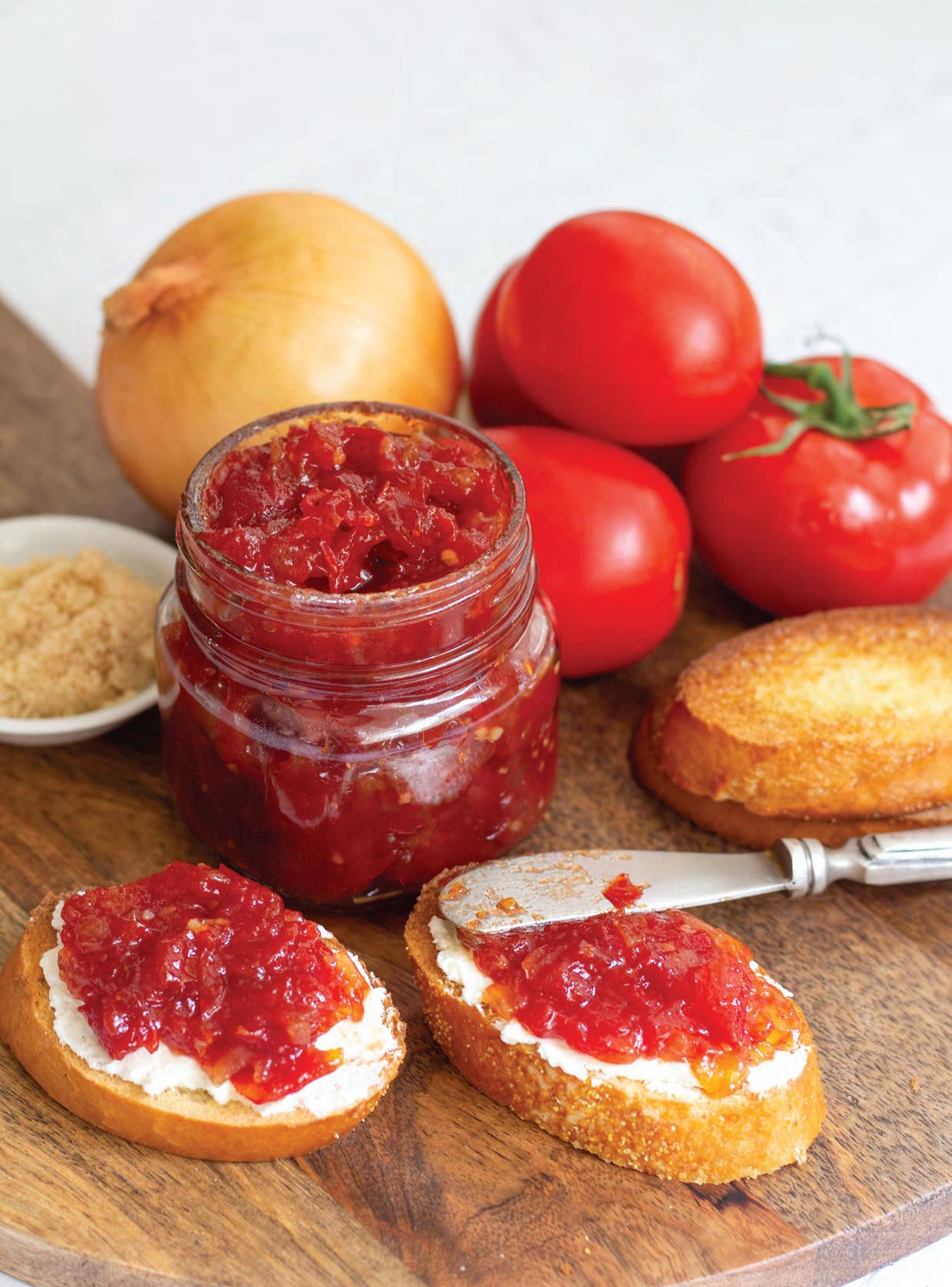
Cook of the Month: Kathy Ledford Gledhill, Sand Mountain EC

Kathy Gledhill likes to describe her “Tomato Jam” as “a scaled-down version of tomato relish.” She was trying to think of a way to make the relish without cooking a large quantity, and she came up with this month’s winning recipe. With July being a peak month for eating in-season fresh tomatoes, her jam is a different way to use the favorite summertime food. “I like to use fresh tomatoes and I prefer Roma tomatoes, but it doesn’t matter,” she says. The Roma variety have less seeds and their firm consistency just make them easier to chop. Kathy also uses brown sugar in this recipe, when normally she uses white sugar when she makes a relish. “I just try different things,” she adds. The tomato jam pairs well with any other vegetable and goes very nicely with cornbread, says Kathy. While she doesn’t can her jam, it could be canned to last longer. “I just like to think of it as a way to preserve tomatoes.”
WIN $50!
November:
Slow Cooking
Enter by: August 4
More upcoming themes and deadlines: December: Cookie Contest | Sept. 1
Visit our website: alabamaliving.coop
Email us: recipes@alabamaliving.coop
USPS mail: Attn: Recipes, P.O. Box 244014 Montgomery, AL 36124
Cook of the Month wins $50! Recipes can be developed by you or family members. You may even adapt a recipe from another source by changing as little as the amount of one ingredient. Chosen cooks may win “Cook of the Month” only once per calendar year. To be eligible, submissions must include a name, phone number, mailing address and co-op name. Alabama Living reserves the right to reprint recipes in our other publications.
Tomatoes and Macaroni
1 large onion, diced
1/2 teaspoon salt
1 29-ounce can stewed tomatoes (or 1 quart home canned tomatoes)
2 cups elbow macaroni
2 cups water
Place diced onion in a 4-quart pot. Add 1 large can stewed tomatoes, 1/2 teaspoon salt, 2 cups of water. Bring these ingredients to a boil. Stir in 2 cups of elbow macaroni. Return to a boil and cover; reduce heat. Cook on low for 15 minutes. Serve hot.

Linda Evans
Wiregrass EC
Tomato Jam
2 to 3 pounds tomatoes, seeded, cored and chopped
1 small onion, chopped
1 teaspoon garlic
1 teaspoon salt
¾ cup brown sugar
2 or 3 tablespoons apple cider vinegar
Put all ingredients in a heavy saucepan. Bring to a boil and simmer until thickened. Let cool. Put in jars and store in the refrigerator. Will keep for about 10 days.
Patriotic Tomato Tart
1 cup flour
1 teaspoon bak ing powder
1/2 teaspoon salt
1/2 cup unsalted butter, cut in pieces
1/2 cup light sour cream
2 cups grape tomatoes, cut in half
8 ounces blue or purple potatoes
4 ounces crumbled feta cheese
Whisk flour, baking powder, and salt. Add butter and mix it all into crumbs. Stir in the sour cream until you have a ball of dough. Cover and refrigerate 2 hours. Steam the potatoes, then thinly slice. Preheat oven to 425 degrees. Roll the dough into a big circle and lay it on a baking sheet. Place potatoes, cheese, and tomatoes on the dough (bonus points if you make a flag design!). Fold edges of the dough in about an inch. Bake 25 minutes, until the crust is golden brown. Cool 10 minutes, then slice. If you can't find blue/purple potatoes, use small red potatoes. Serve the tart on a big blue platter for a patriotic look.
Robin O'Sullivan
Wiregrass EC
Salsa
1 quart tomatoes
1/2 tablespoon cumin
1 tablespoon lime juice
1 tablespoon minced garlic
15 diced jalapenos, from a jar
1 package cilantro
Blend all ingredients together until smooth.
LaWanda Noonan
Joe Wheeler EMC
ried Green tomatoes hold a special place in the hearts of many. However, I have found as I grow older that some of my most beloved Southern fare no longer agrees with my waistline. It was this that led me on a quest to find healthier swaps for some of my favorite things. Made with almond flour, almond milk and parmesan cheese, and by baking them in the oven gives these Oven Fried Green Tomatoes all of the texture and flavor you expect but with a lot less guilt. Find more recipes at thebutteredhome.com.

Easy Tomato Pie
1 9-inch pie crust, prepared according to pack age directions
3 large tomatoes, thinly sliced
2 teaspoons sea salt
¼ cup fresh basil, chopped
2 cloves garlic, minced
1 small bag cheddar cheese, shredded
1 small bag mozzarella cheese, shredded
¼ cup mayonnaise
Thinly slice tomatoes. Place on paper towels in a single layer. Sprinkle with sea salt. Allow to sit 10 minutes to draw out moisture. Blot tomatoes with dry paper towel. Arrange tomatoes in cooked and cooled pie crust. Mix mayonnaise with half the cheeses, minced garlic and chopped basil. Spread mixture over tomatoes. Sprinkle remaining cheese over top. Bake until cheese is melted and bubbly, approximately 35 minutes. Let pie cool and enjoy!
Robbie Vantrease Cullman ECFBaked “Fried” Green Tomatoes
3-4 medium green tomatoes, sliced
1/2 cup almond milk
1 egg
1/2 cup almond flour
1/2 teaspoon garlic powder
1/2 teaspoon smoked paprika
¼ teaspoon cayenne pepper
1/2 teaspoon pink salt
Parmesan cheese
Preheat oven to 425 degrees. Fit a sheet pan with a small amount of cooking spray or parchment paper.
Slice tomatoes to about ¼ inch thick. Mix almond milk and egg, whipping until combined in a small bowl. In another bowl, mix almond flour, garlic powder, paprika, cayenne and salt.
Place tomato slices in egg mixture and remove with a fork. Dredge in dry mixture and set aside on the prepared sheet pan until all are battered. Sprinkle with parmesan cheese and bake for about 10-15 minutes until brown. Carefully remove from the oven and turn tomatoes over and sprinkle with more parmesan cheese. Return to the oven and bake for another 5-10 minutes until done. Cool and serve.
Joy's Chili Mix
5 pounds of tomatoes, peeled and cored
3 jalapeno peppers, seeded and chopped
2 large onions, chopped
2 green bell peppers, chopped
3 cloves of fresh garlic, minced
1/2 cup apple cider vinegar
2 teaspoons dried oregano
1/2 teaspoon cumin
2 tablespoons salt
2 tablespoons sugar
1 tablespoon black pepper

Combine all the chopped vegetables, garlic, and apple cider vinegar in a pot and cook for 15 minutes, or the consistency that you prefer. Add to the dry seasonings and cook another 5-10 minutes. Pour your mix into warm Mason jars and leave 1/2-inch space at the top of the jar. Wipe the rims carefully. Place your lids and rings on the jars and place in a rolling water bath for 15 minutes. Check USDA recommended time according to your altitude. Place on counter and listen for the glorious sound of popping! Cook's note: Add canned beans, a pound of meat and two tablespoons of chili powder, plus a jar or two of mix to make a meal.
Joy Griswold Dixie EC
Real Simple Pico de Gallo
2 large fresh and vine-ripened tomatoes, chopped
1 tablespoon fresh cilantro, chopped
1 sweet onion, chopped finely
1 large green pepper, pitted and chopped
1 jalapeno pepper, pitted and chopped (optional)
1 fresh lime
Salt, a pinch
Fresh cracked pepper, to taste Tortilla chips
Mix all ingredients together without mashing or squishing, toss lightly, and make sure all the veggies have lime juice on them to keep the color. Cook's note: You can add salad shrimp to this recipe for ceviche or add roasted corn for a nice contrast!
Carla P. Norman Covington ECRoasted Tomato Soup
6 Roma or vine-on tomatoes, cut in half, stem end trimmed
1 or 1.5 pound container cherry or grape tomatoes, left whole
1 large yellow or white onion, halved and thinly sliced
4 ribs celery (with leaves), diced into 1-inch pieces
5 cloves garlic, smashed
2 tablespoons olive oil
2 bay leaves
2 tablespoons chicken soup base, see cook’s note
5 cups water
2 tablespoons unsalted butter
1 cup heavy cream or 8 ounces evaporated milk
Salt and pepper, to taste
Optional toppings: freshly shaved Parmesan cheese and croutons
Preheat oven to 375 degrees. Place prepared vegetables in 9x13-inch glass pan and add olive oil. Stir until vegetables are coated with oil. Do not cover pan; roast for 1.5 hours until celery and onions are tender, and vegetables are a bit caramelized. Remove pan from oven and let cool for 10 minutes. Scoop vegetables and drippings into a 6-quart stockpot. (Use a stainless steel pot; avoid a pot with a non-stick surface.) Add 5 cups water, soup base and bay leaves; stir well until soup base is dissolved. Bring soup to a boil, then reduce the heat to a simmer; stir well and cover the pot with a lid; cook for 20 minutes. Fish out the 2 bay leaves and remove the pot from the heat. Using an immersion blender, blend to a rustic consistency, not totally smooth. Put pot back on the burner; add butter and cream or evaporated milk; stir until milk and butter are blended in. Add salt and pepper to taste. Simmer for 10 minutes. Soup is ready to serve.
Cook's notes: The celery and celery leaves adds a deep savory dimension. It’s important to cut the celery and onions into small pieces so they become soft in the oven and are easier for the immersion blender to chop. Five cups of chicken broth can be substituted for the soup base and water. I prefer soup base because it’s more flavorful. This soup is delicious hot or cold.
Jane Alexander Baldwin EMCQuick Tomato, Basil and Bacon Tart

1 teaspoon olive oil
4 slices unsmoked bacon, diced
1 puff pastry sheet, thawed
2 tablespoons pesto, plus additional for garnish
3 ounces cherry tomatoes, halved
1 4-ounce package baby mozzarella
Fresh basil, cut plus additional for garnish
Preheat oven to 375 degrees and line a baking sheet. Heat oil in frying pan and fry bacon pieces until crisp. Set aside. Lay out puff pastry on a baking sheet and score a 1/3-inch border around the edge, taking care not to cut all the way through. Spread pesto on the pastry. Top with bacon, tomatoes and mozzarella. Bake for 20 minutes until pastry is puffed around the edges and is golden in color. Serve with extra pesto drizzled and fresh basil on top. Serve with a salad.
Barbara LawsonBaldwin
EMCFredabelle’s Salsa
8 cups fresh tomatoes, peeled and diced
3-4 red bell peppers, diced 11/2 cups onion, diced
2 green bell peppers, diced
1 cup apple cider vinegar
2 teaspoons salt
1 tablespoon garlic salt
¾ cup brown sugar
2 6-ounce cans tomato paste
2 8-ounce cans tomato sauce
Cook tomatoes and drain some liquid before adding other ingredients. Simmer together for 1 hour and seal in jars to store. Can be kept in the refrigerator as well.
Nancy SizemoreBaldwin EMC
Seal in savings with efficient exterior doors
Q:I like the style of my front door, but it is drafty. Can you recommend ways to fix the drafts and make it more energy efficient?
A:The front door of your home has a lot of meaning. It sets the stage for the home and is the first impression for your guests. Beyond curb appeal, the front door is a good place to look for energy savings.
Efficient exterior doors seal tightly and don’t allow air to pass through. Limiting airflow from exterior doors can result in lower heating and cooling costs. Throughout the years, the construction of exterior doors has improved to increase their efficiency. If your door is older, it likely is not insulated.
There are two strategies to address an inefficient front door: Purchase a new one or work with what you have.

If you want to replace your front door for aesthetic purposes, make it more functional or improve its efficiency, consider upgrading to an ENERGY STAR®-certified model. The ENERGY STAR® certification ensures the door you buy meets efficiency criteria for your local area. It also means the National Fenestration Rating Council independently tested and verified the door.
Certification requires any windows in the door to be double or triple pane to reduce heat flow, which results in a more efficient home. While windows in doors offer aesthetics, more glass means less efficiency. ENERGY STAR® offers different criteria based on the amount of glass the door has. That means that the bigger the windows in a door, the lower the efficiency. The most efficient doors have no glass or windows in them.
U-factor is the primary rating for efficiency on doors and windows. U-factor is the inverse of R-value, which is the rating used for insulation. Unlike R-value where higher is better, the lower the U-factor, the more energy efficient the door. Check the U-factor on ENERGY STAR® doors at your local hardware store or online to help choose the most efficient door in your preferred style.
ENERGY STAR®-certified doors are made of the most efficient materials, such as fiberglass, wood cladding and steel with polyurethane foam core. They are built to fit snugly into their frames, reducing drafts and airflow.
When it comes to doors, you don’t have to sacrifice style for efficiency. There are many styles available to match the architecture, whether your home is historic or modern.
When completely replacing a door and the frame, you can use expanding foam or caulk to fill the space between the door jamb and structural framing. ENERGY STAR® doors have specific installation instructions to ensure the desired efficiency.
If a new door isn’t in your budget, there are less expensive options to reduce air leakage and improve your home’s efficiency.
All of that coming and going throughout the years can wear out weatherstripping. If you can see daylight around the edges of the door or underneath it, it’s time to stop those air leaks.
Weatherstripping around the door jamb can be adjusted to make a snug seal or replaced if it’s too far gone. Apply one continuous strip along each side, and make sure it meets tightly at the corners.
There are many different types of weatherstripping products on the market, so shop around for what’s right for you. Don’t forget the door sweep at the bottom of the door.
Adding a storm door can also help and is less expensive than replacing the entire door. Most storm doors have options for using a screen or glass. Swapping the screen for the glass insert can help save energy in both the winter and in the summer if you use air conditioning. Consider a storm door that’s easy to switch between glass and screen so you can maximize the benefits.
Open the door to energy savings by improving the efficiency of your exterior doors––without compromising the aesthetics of your home.






Teaching kids about fishing creates bonding experiences

My dad always took part of his vacation during July to spend it fishing with his sons. With school out, this month offers an excellent time to introduce children to fishing.
As the youngest, I came along much later than my two brothers and older sister, so I spent considerable time with my dad hunting and fishing after the older three left the house. Dad always used to say, “You can either go fishing or take small children fishing, but you can’t do both at the same time. Decide what you are going to do and stick with it.”
By that, he meant that if adults want to go fishing, they should go with likeminded, skilled anglers and enjoy themselves. However, if they want to take young children fishing, they must make the day all about the youngsters. They might not catch as much, but they will certainly catch infinitely more important things. Great memories!
Many people today don’t understand this philosophy. They want to catch fish more than they want to take their children fishing. Dad would rather watch a child catch a tiny bluegill than for himself to land a state record. When I was young, he spent uncountable hours tying on and baiting hooks, untangling knots, unsnagging baits, etc. and never yelling at me. He seldom even picked up his own rod.
Taking young children fishing requires extreme patience. They will make mistakes. Don’t expect them to perform like master anglers. I’ve fished with many of the top professional anglers in the world. Even the best of them snag lures, backlash their reels, break rods and lose fish occasionally.
Instead of yelling, calmly teach children how to perform certain actions correctly. Don’t do everything for a child. Young sportsmen learn best by doing and even making their own mistakes. Just do what’s necessary to keep the child and others safe without breaking anything.
When teaching youngsters how to fish, keep it simple and fun. Fish for whatever bites. A young child doesn’t care what pulls on the line. A child will enjoy catching what many anglers consider
an undesirable species or even a nuisance. Watch that child’s face light up when hooking a big one.

Start youngsters with an old cane pole or cheap child’s rod that won’t cost much to replace if – or should I say “when” – the child breaks or loses it. A worm or cricket dangling under a bobber waiting for a bluegill or catfish to take it down builds a foundation for that child to learn more advanced techniques.
In salt water, buy some shrimp and find a place where youngsters won’t need to do much casting. Thread a shrimp on a hook, tie on a sinker and drop it straight to the bottom. Don’t worry about chasing trophy speckled trout. Anything that bends a rod would excite young anglers. I’ve seen children battle 3-pound gafftopsail catfish with more enthusiasm than people fighting tuna weighing nearly 200 pounds.
Make it more than a fishing trip. Dad always tried to turn every outing into an adventure, as well as a teaching experience, even if we just walked along a ditch looking for frogs. He always took time to explain how everything connected in nature. Dad pointed out different birds or anything else we encountered. Even if fish were biting like crazy, he would pause to watch a mother otter swim with her babies or a hawk dive to catch its breakfast.
Children easily grow bored. Keep them active and involved in activities. Bring plenty of snacks and refreshments. Don’t stay out too long. If children want to do something else, let them do it as long as it’s safe. When they have had enough, go home.
Alabama manages 23 stocked public fishing lakes in 20 counties. These lakes vary in size from 13 to 184 acres. Most exist in a park-like setting where anglers can catch various species from bream to bass off the bank or in boats. At some lakes, people can rent boats and equipment. These lakes make outstanding places to teach children how to fish.
Fishing with small children isn’t about catching a limit of lunkers, but landing lasting memories. Spending that time takes effort, sacrifice, patience and frequently, frustration. However, a parent will never meet a better fishing companion than one crafted over time.
CECIL PIGG CECIL PIGG STEEL TRUSS, INC.

P.O. BOX 389, ADDISON, AL 35540
WE SELL: Steel Trusses • Hay Barns Lumber • Equipment Sheds Building Material Packages Painted Metal • Work Shops Insulation • Kneebraces

Galvalume Metal
STEEL TRUSS BUILDINGS BUILT TO YOUR SPECIFICATIONS

256-747-8178 • FAX: 256-747-8760

DOUG HANNON’S FISH & GAME FORECAST

The Moon Clock and resulting Moon Times were developed 40 years ago by Doug Hannon, one of America’s most trusted wildlife experts and a tireless inventor. The Moon Clock is produced by DataSport, Inc. of Atlanta, GA, a company specializing in wildlife activity time prediction. To order the 2023 Moon Clock, go to www.moontimes.com.

The party’s over?
You may remember Willie Nelson’s 1967 hit song, “The Party’s Over.” Like most country songs, it is about a broken relationship – this one with his wife. He sings about a party where everyone is dancing and having fun, and he is crying, but that doesn’t keep her love for him from dying. His wife delivers him a final message, which Willie recounts in the closing lines of the song: Sweetheart, the party’s over
Turn out the lights
The party’s over.
They say that all Good things must end.
Call it a night
The party’s over
And tomorrow starts
The same old thing again.
What does Willie Nelson have to do with electricity? Well, there are some similarities. Everyone has been having a big time, partying hard for decades, enjoying reliable and affordable electric service. Everyone, like Willie, has taken that relationship for granted. It was assumed that our friend - reliable, cheap electricity - would be with us forever, and we could just keep partying like there was no tomorrow.
The party’s not quite over yet, and we aren’t ready to turn the lights out, but the outlook is not particularly positive.
Earlier this year, the PJM Interconnection, an Independent System Operator serving 13 states and approximately 65 million people in the northeast, released a report stating that fossil fuel electric generation plants are being shut down faster than new replacement wind and solar are being built. Plant closings are a result of policies of the EPA and some states.
About half the retired fossil fuel capacity will be replaced by 21,000 megawatts (MW) of wind, solar and batteries. However, unaccounted for is the substantial electric load growth due to increasing electrification of the economy and electric vehicles. The report concludes that, without immediate actions, PJM will suffer “energy imbalances” by 2030, if not before. That means –to those not accustomed to electric utility speak – there will be rolling blackouts.
In May, four Federal Energy Regulatory Commissioners testified before the U.S. Senate Energy and Natural Resources Committee that the U.S. electric grid is facing unprecedented reliability challenges. Mark Christie, a Republican Commissioner, stated: “We are retiring dispatchable generating resources at

a pace and in an amount that is far too fast and far too great and is threatening our ability to keep the lights on.” Democratic Commissioners were more reserved, but both testified the electric grid was at risk and all generation resources, fossil fuel and renewables, were needed to maintain electric reliability for the foreseeable future.
The National Electric Reliability Corporation (NERC), the organization of electric utilities responsible for electric reliability in the country, released its 2023 Summer Assessment in May which forecasts that two-thirds of the U.S., including almost everyone west of the Mississippi River, could experience power shortages on very hot days with little wind.

Texas, in particular, is called out in the report. Despite adding considerable solar generation to the state’s portfolio, electric demand has grown even faster with an influx of people moving into Texas. NERC forecasts a 19% chance of a grid emergency after 8 p.m. on a hot summer night when the sun is not shining.
One would think that with the reports of energy imbalances, grid emergencies, and electric capacity shortages, the Biden Administration and EPA would make plans to avoid a national disaster. After all, these are serious reports about serious issues that involve the very essence of our lives.
On the contrary, the EPA recently finalized its Good Neighbor Policy that requires a reduction in nitrous oxide emissions from fossil fuel-fired plants over 22 states this summer. The EPA states the Good Neighbor Policy won’t jeopardize grid reliability, but at the same time, states regulatory waivers may be needed in the event of a power crunch. Party on!
Additionally, the EPA revised the Clean Air Act requiring coal and most natural gas plants to add Carbon Capture and Sequestration (CCS) systems, or to burn hydrogen, by 2030. The CCS systems have not been proven anywhere near the size and scale required for the task ahead. Burning hydrogen in electric generation plants may work; however, hydrogen production is very expensive, and it is difficult to transport and handle. So many problems remain in technological development and the supply chain for such major systems in just six and a half years. Party harder!
Rolling blackouts are becoming more common and more difficulties are predicted in the not-too-distant future, and the federal government continues to tighten the noose. It may not quite be time to cue up ole Willie, but he is warming up his vocal cords –sweetheart, the party’s over, turn out the lights.
I hope you have a great month.

Managing one of Alabama’s most valuable resources
When I think about water resources in Alabama, I often remember the great times I’ve enjoyed out on our lakes with family and friends. In July, there is nothing quite like taking a cool dip in the fresh waters that surround us.
After all, at least one-sixth of the surface area of Alabama is comprised of lakes, reservoirs, ponds, wetlands, estuaries and flowing rivers and streams.
TVA manages the water supply throughout our region to support recreational opportunities – and also to ensure sustainable water supplies are available to run power plants, support wildlife and provide clean drinking water to residents.
The effective management of our water supply is paramount to Alabama’s agricultural industry as well. Members of our staff recently talked with the owners of Bridgeforth Farms, one of the largest farms in North Alabama that produces cotton wheat, corn, soybean, sorghum and canola.
The farm has been in the Bridgeforth family for five generations, after George Bridgeforth Sr., a freed slave, made his first purchase of land 12 years after the Civil War ended.
Current owners Gregory and Billy Bridgeforth, representing the fourth generation, and Lamont, Carlton and Kyle, representing the fifth generation, share an immense appreciation for this life-giving resource.
“Clean water is equally important as clean air,” Billy says. “TVA water management is vitally important to our farm.”
Bridgeforth Farms receives irrigation water from TVA’s Wheeler Reservoir, and about 98% of the farm’s irrigation is supplied by the Tennessee River.

Providing a sustainable supply of water to farms like Bridgeforth requires a keen understanding of resources, and careful planning and foresight to ensure water use aligns with the needs of farmers now and into the future.
In developing their Water Supply Report, TVA specialists analyze the amount of water being used in the region every five years. They then use this information to predict water supply levels 25 years out.
In 2022, a new version of the report provided key insights into how water is used today and how stakeholders may use it in 2045.
The forecasting helps TVA’s specialists analyze use and adjust programs to best support the region’s continued economic and population growth.
And a glimpse at water use in recent years tells the tale.
From 2015 to 2020, water withdrawals declined nearly 17%, with an additional 11% drop expected by 2045.
“Water use analyses allow TVA to effectively manage the integrated operation of the TVA river system,” TVA Water Resources engineer Jenny Sharkey says.
The reuse of water in the region also speaks to sustainability initiatives.
In 2020, for example, about 8.4 billion gallons of water were withdrawn each day, but the system returned about 98% for reuse, according to the Water Supply Report.
“The residents of the Valley are good stewards of the water,” TVA Water Supply program manager Gary Springston says.


The effective management of water –both use and reuse – undergirds TVA’s long-term goals of supporting the environment while strengthening economic development and energy infrastructure.
And it’s all designed for a noble purpose: Serve those who call this region home.
“The way we operate our integrated river system is for the people of the Valley,” says Amanda Turk, manager of Hydrologic Impacts and Risk Evaluation. “Our mission is for the people of the Valley.”
Ultimately, sustainable and clean water ensures farms like Bridgeforth can continue supplying high-quality products to customers.
How To Place a Line Ad in Marketplace
Closing Deadlines (in our office):
September 2022 Issue by July 25
October 2023 Issue by August 23
November 2023 Issue by September 23
Ads are $1.75 per word with a 10 word minimum and are on a prepaid basis; Telephone numbers, email addresses and websites are considered 1 word each. Ads will not be taken over the phone. You may email your ad to hdutton@areapower.com; or call (800)410-2737 ask for Heather for pricing.; We accept checks, money orders and all major credit cards. Mail ad submission along with a check or money order made payable to ALABAMA LIVING, P.O. Box 244014, Montgomery, AL 36124 – Attn: Classifieds.
Miscellaneous
WALL BEDS OF ALABAMA - SOLID WOOD & LOG FURNITURE – Outdoor Rockers, Gliders & Swings, HANDCRAFTED AMISH CASKETS $1,599 - ALABAMA MATTRESS OUTLET – SHOWROOM Collinsville, AL – Custom Built / Factory Direct(256)490-4025, www.wallbedsofalabama.com, www.alabamamattressoutlet.com
TIMESHARE VICTIMS! - Call (800)223-1770TimeShareBeGone.com - Timeshares legally cancelled for less - A+BBB Rating - Five Star Reviews - 100% Money Back Guarantee! Trust is our reputation! Since 2007
FUNERAL INSURANCE PLANS FOR ANY BUDGET. No Exam, East Qualification. Visit finalexpenseassured.com or call (813)352-2587
Answers to puzzle on Page 28

Vacation Rentals
GATLINBURG – DOWNTOWN LUXURY CREEKSIDE CONDO – 2BR / 2BA, sleeps 6 –aubie552@gmail.com, (256)599-5552
AFFORDABLE BEACHSIDE VACATION CONDOS – SUGAR BEACH CONDOS in ORANGE BEACH, AL – Rent Direct from Christian Family Owners – Lowest Prices on the Beach! www. gulfshorescondos.com, (251)752-2366, (251)656-4935
LAKE HOMES / CABINS – Verified Owners. No Booking Fees. ALAVHR.com


MENTONE, AL LOOKOUT MOUNTAIN COTTAGE RENTALS – Best brow views, River Front –cottagesofmentone.com, Call or text (504)4818666
PANAMA CITY BEACH CONDO – Owner rental – 2BR / 2BA, wireless internet, just remodeled inside and outside – (502)7777819, larrysusemichel@reagan.com, www. theroneycondo.com
Pet Friendly – Save $$$ by booking directly from Verified Owners. ALAVHR.com
MILITARY / SERVICE DISCOUNTS on dozens of rentals. No Booking Fees. (251)333-6500, ALAVHR.com
OWNERS – Join the fastest growing regional site in Alabama. Low annual fee. Verified Owners, no booking fees or commissions. Alabama Vacation Home Rentals. Locally Owned and Operated. (251)333-6500, ALAVHR.com



GULF SHORES / ORANGE BEACH / FORT MORGAN – Choose from hundreds of beach houses and condos! Verified Owners. No Booking Fees. ALAVHR.com
BEAUTIFUL HOME IN CARRABELLE, FL – “FISH A PIER HERE” – 3BR / 2BA, Private Dock for Fishing – (850)697-5300, mysandybeach.com
ORANGE BEACH CONDO, 3BR/3BA; 2,000 SQ.FT.; beautifully decorated; waterfront view; easy beach access; boat slips – GREAT RATESOwner rented (251)604-5226
Land, Lots & Real Estate Sales

MOUNTAIN VIEW HOME SITES ATOP SAND MOUNTAIN. Protective Restrictions, www. pellsgap.com
Education
FREE BIBLE CORRESPONDENCE COURSE –write to P.O. Box 52, Trinity, AL, 35673
Turning the ice cream, before electricity
Among the many labor-saving devices made possible by electricity, the most important to me as a boy was the electric ice cream freezer.
For it was my labor that it saved.
As you know, “Memory Lane” is full of the potholes that reminiscing tends to fill and forget. I am as guilty of “rose tinting” the past as the next guy, and when someone challenges the accuracy of a recollection, I often fall back on what my cousinin-law Kathryn Tucker Windham replied when similarly challenged: “If it did not happen that way, it should have.”
So, it follows that I remember fondly the ice cream that we made and not what it took to make it.
Which was work.
The division of labor was simple: women made the custard and men turned the crank.
In theory.
In reality, my reality at least, the custard magically appeared and it was left to the boys of the family to freeze it.
The men supervised.
And advised.
“You need more ice.”
“The drain hole is clogged.”
“Turn steady.”
“Too fast.”
“Too slow.”
While the boys turned the crank.
The girls helped their mothers.
Slowly, much to slowly as I recall, the custard hardened and the crank got harder to turn. As it did, the fatherly advice took on a certain urgency.

“Don’t stop turning” – advice that convinced us that a missed turn on the crank would spoil the everything.
“Add more ice.”
“Add more salt” – years passed before I learned the role salt played in the freezing process. Some things a boy accepts on faith.
“Clean the drain hole,” for if the salt water did not flow free, it would back up into the ice cream.
Then, after a while, the crank became too hard for a boy to turn. Then one of the men took over and, when it was done, took credit for the doing.
Another life lesson learned. How to get win praise for someone else’s work.
Finally, even the strongest could not turn it.
The paddles were removed and the ice cream that stuck to them was given to the children for a lick or two.
Then the top was put on, the paddle-hole was plugged, and the ice cream was packed for later.
Impatiently, we children waited.
For unless it was an “ice cream social” where the ice cream was the main dish, the ice cream was dessert.
No one had to warn children not to eat too much “dinner” and spoil their ice cream appetites.

Impossible.
So we fidgeted through the blessing, gnawed on a drumstick, played with our vegetables, and remained nearly famished when the time arrived.
“Don’t eat it too fast or you’ll get a ‘brain freeze’.”
Which we did and, we did.
And when that passed, we ate some more.
Now I am certain that the table contained many appetite delights, but none are remembered like I remember the ice cream.
Homemade ice cream made the moment, and the memory, for me.
And, thanks to electricity, I don’t have to turn it myself.

Wishes you a happy and safe summer!
DEADLINE: July 12


Annual photo contest!
Our readers impressed us last year with the quality of their entries in Alabama Living’s annual photo contest, which runs in the September issue. Start thinking now about the 2023 contest, because we want to see more of your awesome photos! First-place winners receive $100, and those photos plus other honorable mentions will be profiled in the magazine. Photos must be uploaded to our website, alabamaliving.coop (no hard copies accepted). The categories this year are nature (animals, insects, scenery), at play (sports, recreation, fun) and travels (events and places of interest). Complete rules are posted on the website. Start sending us your best photos!
 Photo by Arthur Davis Baldwin EMC submitted in 2022 contest.
Photo by Arthur Davis Baldwin EMC submitted in 2022 contest.

